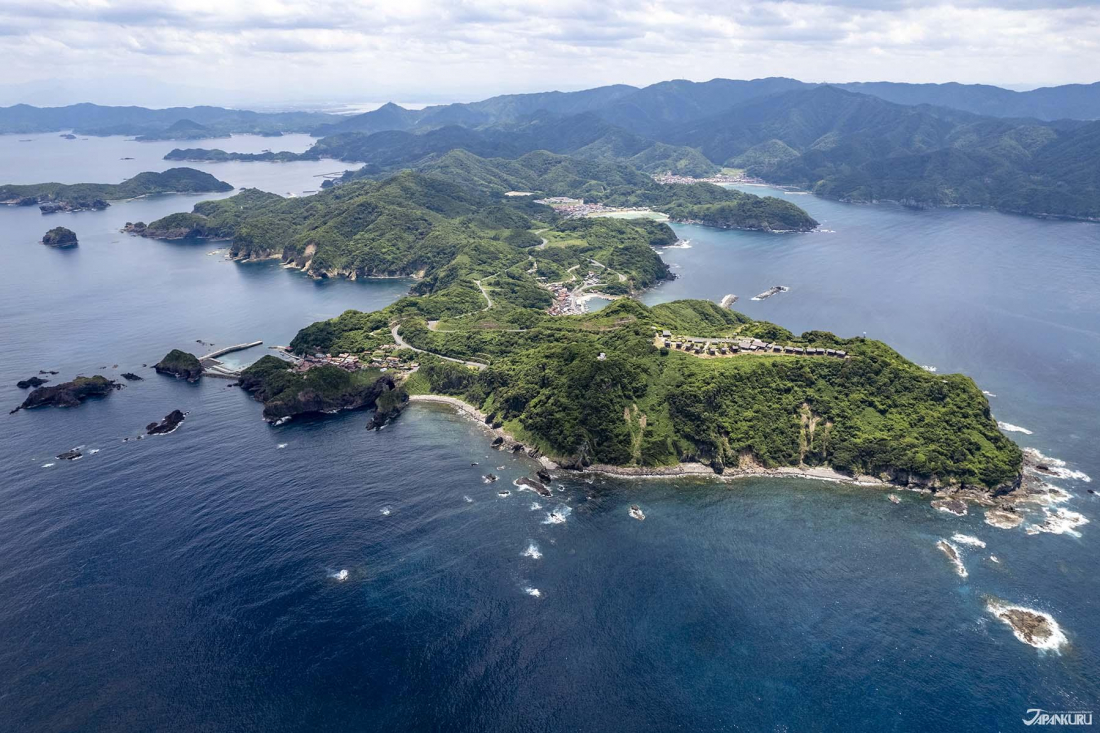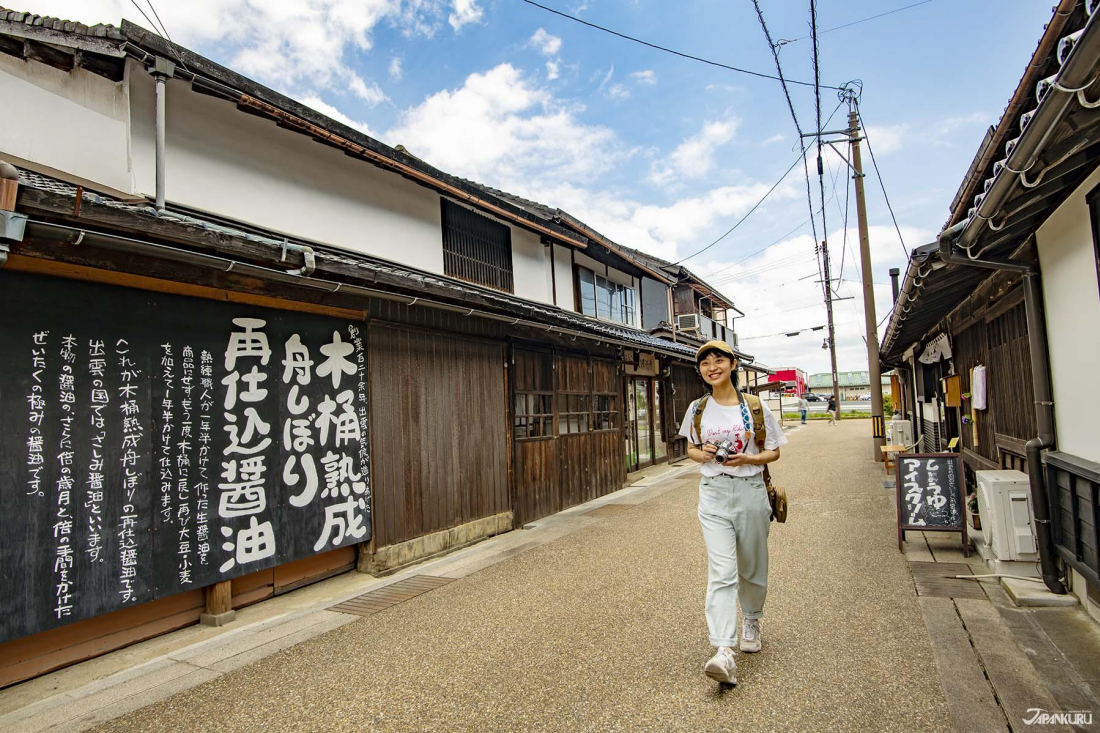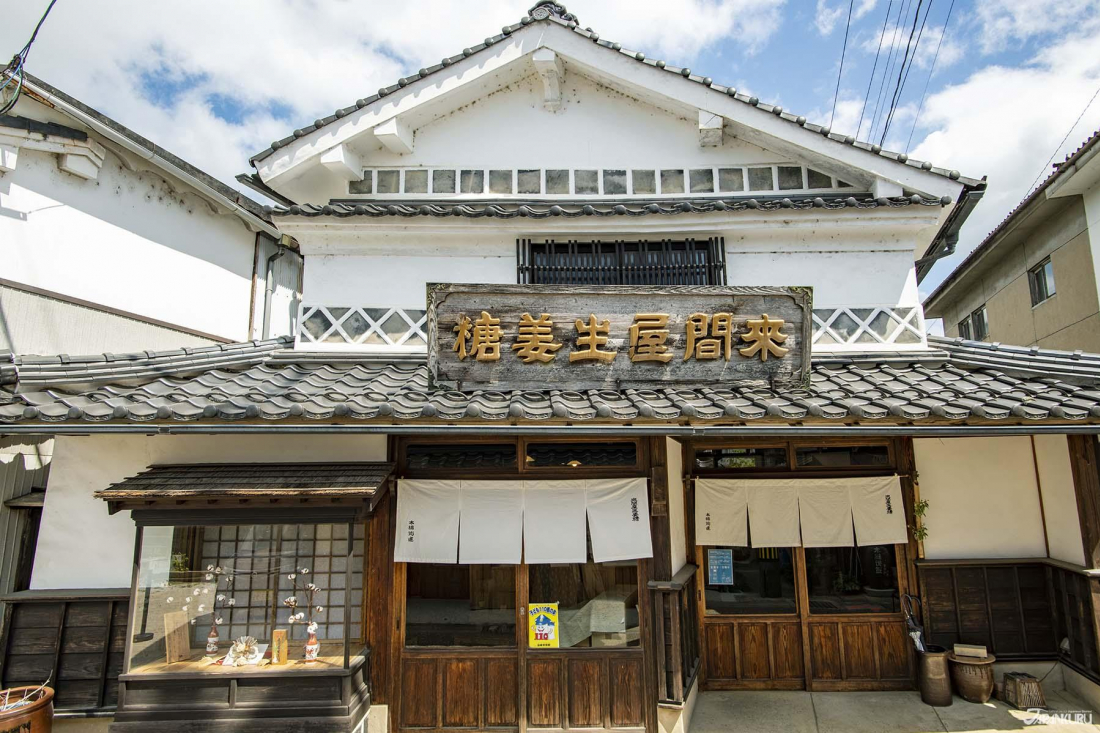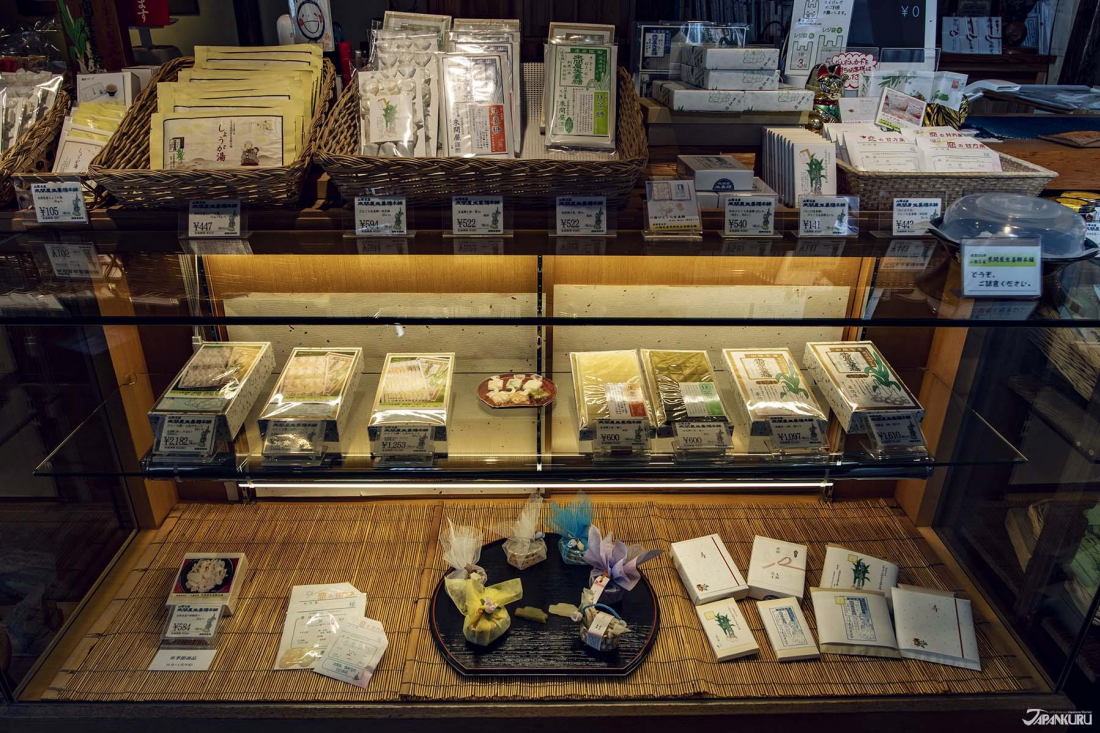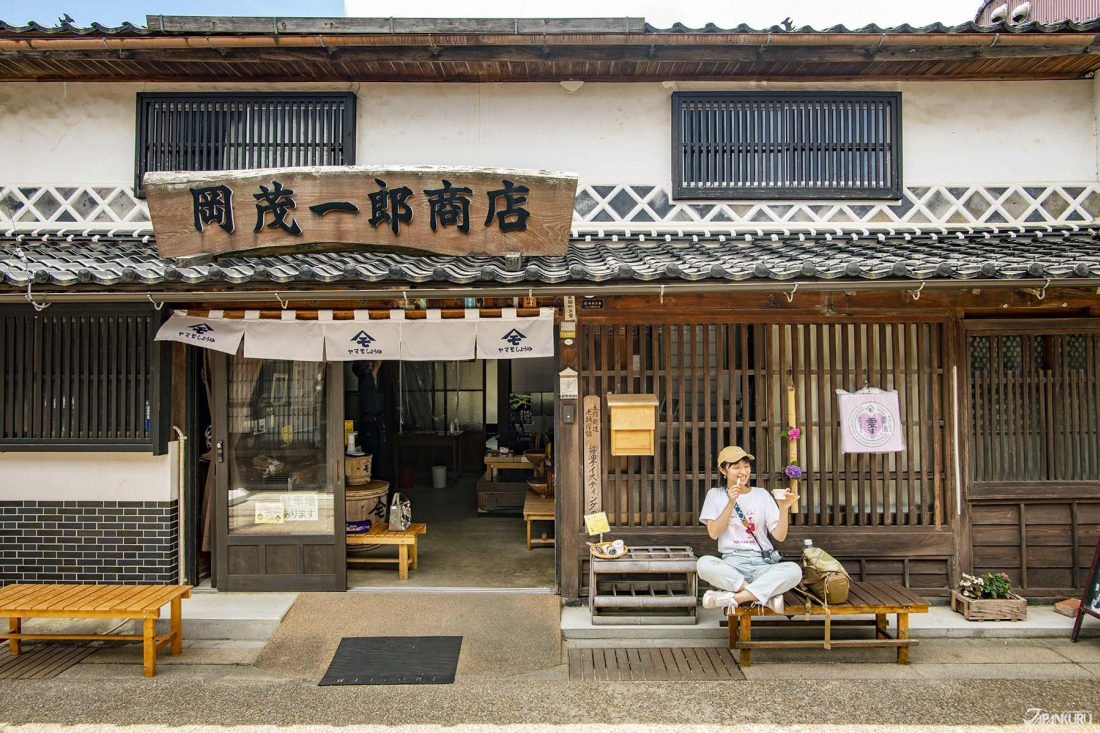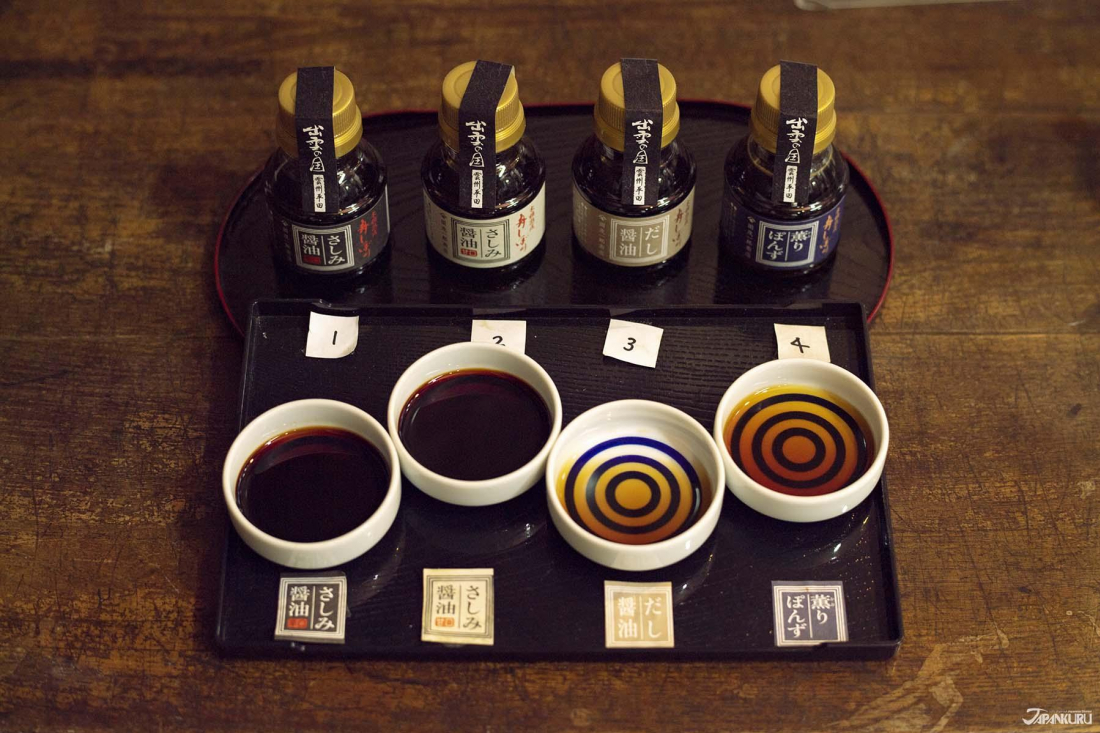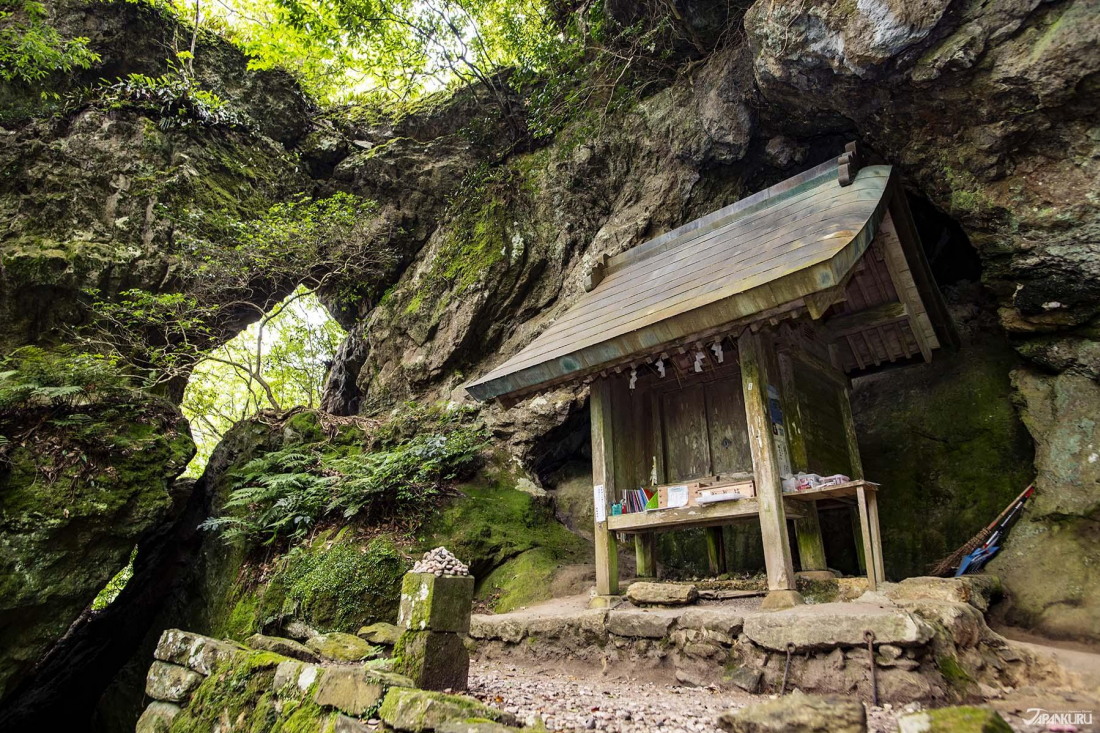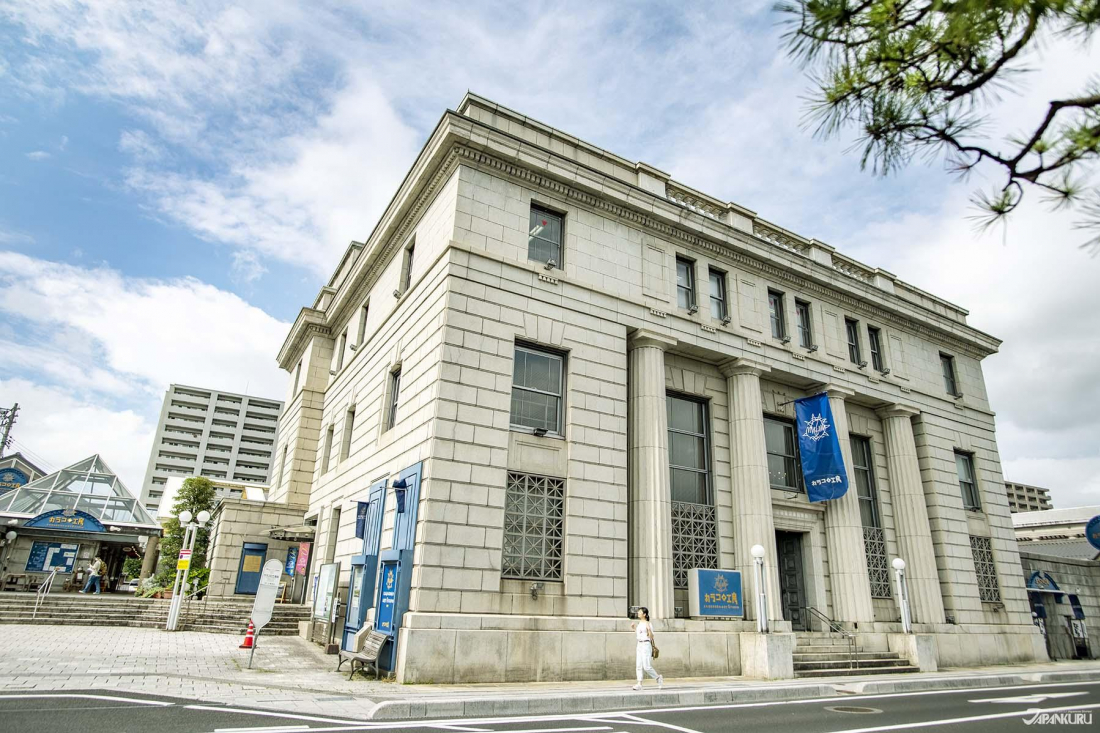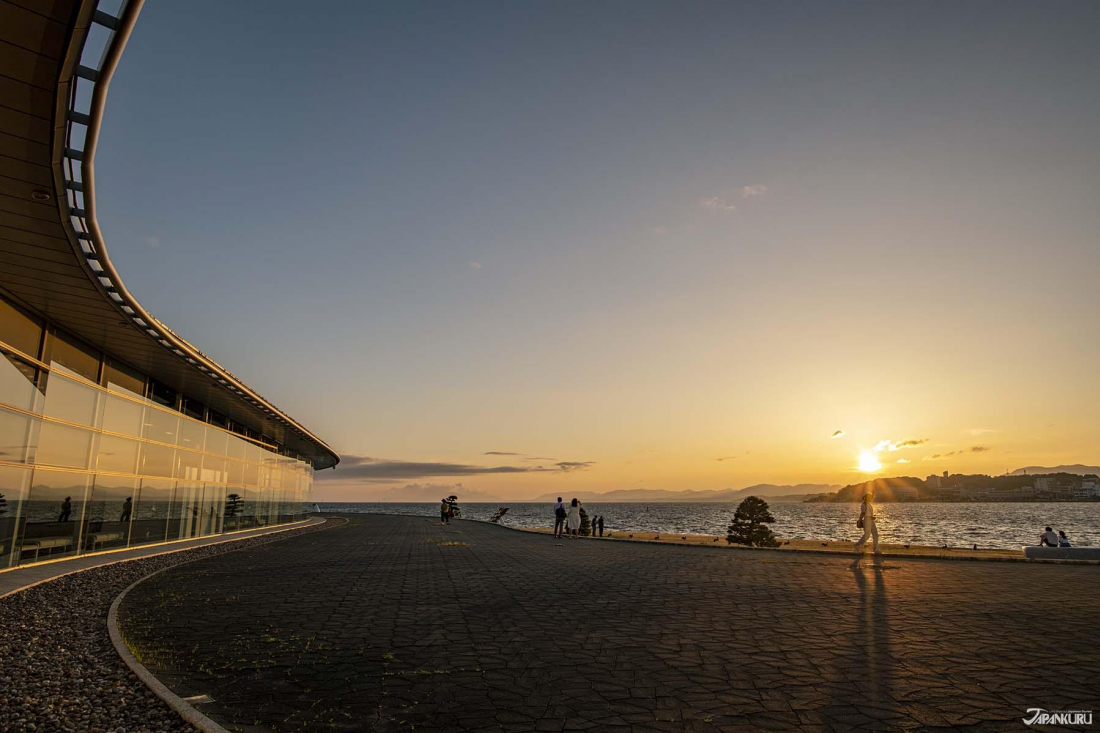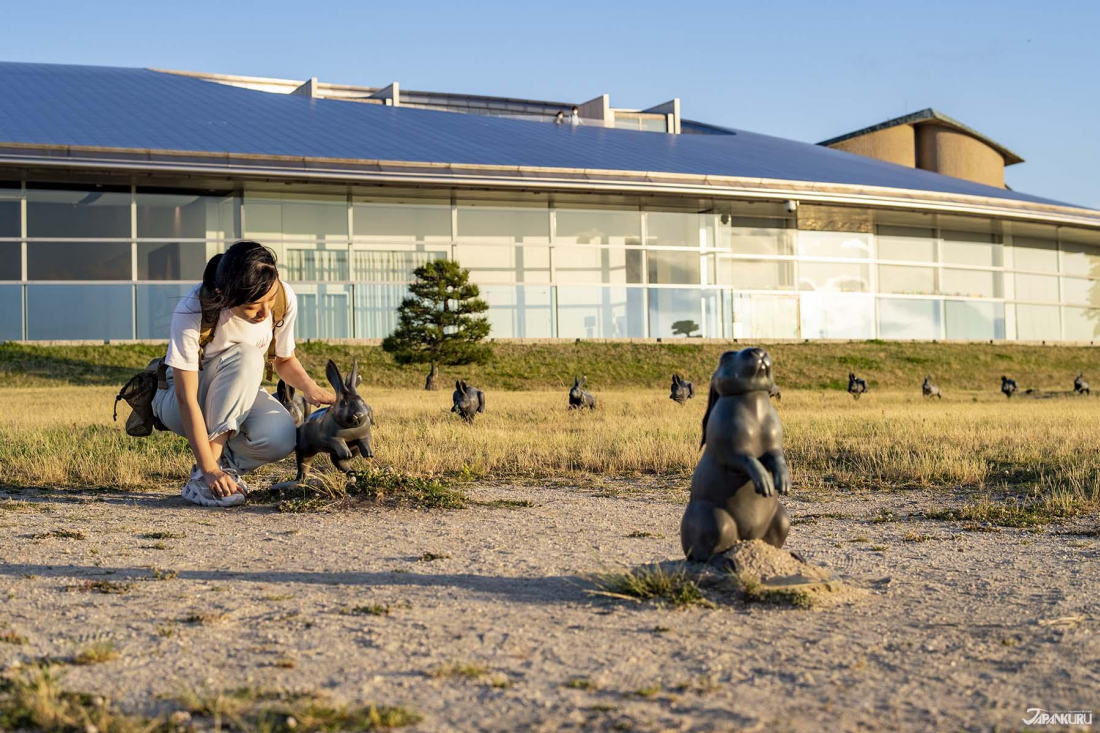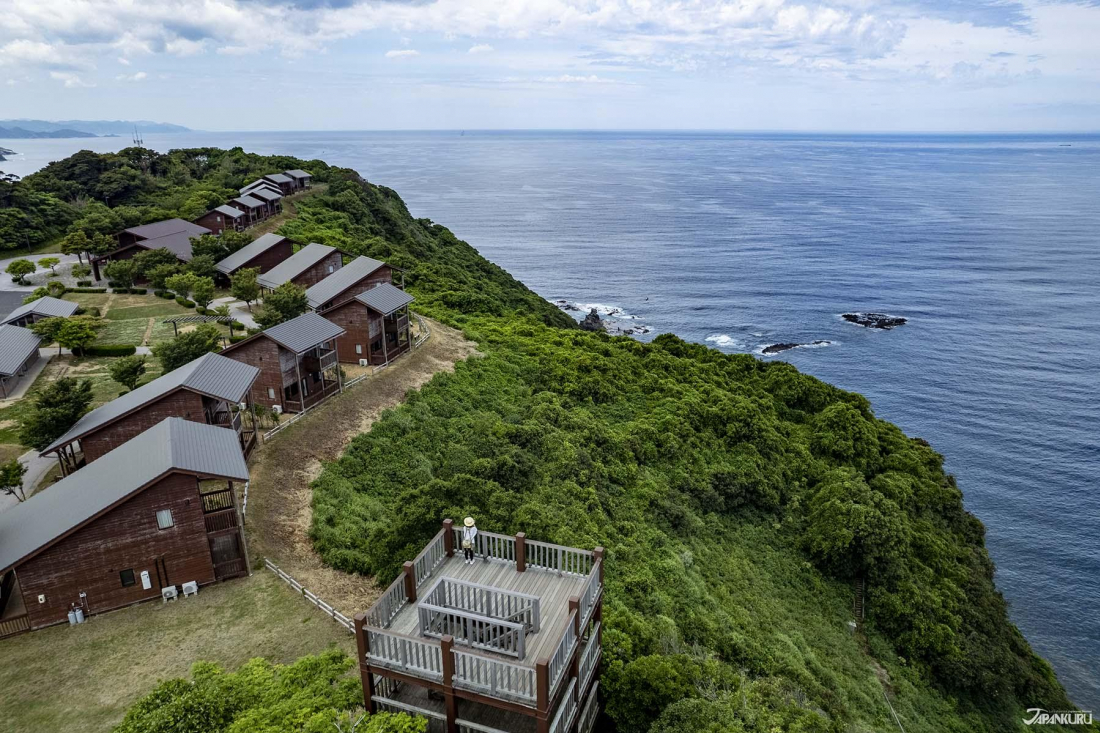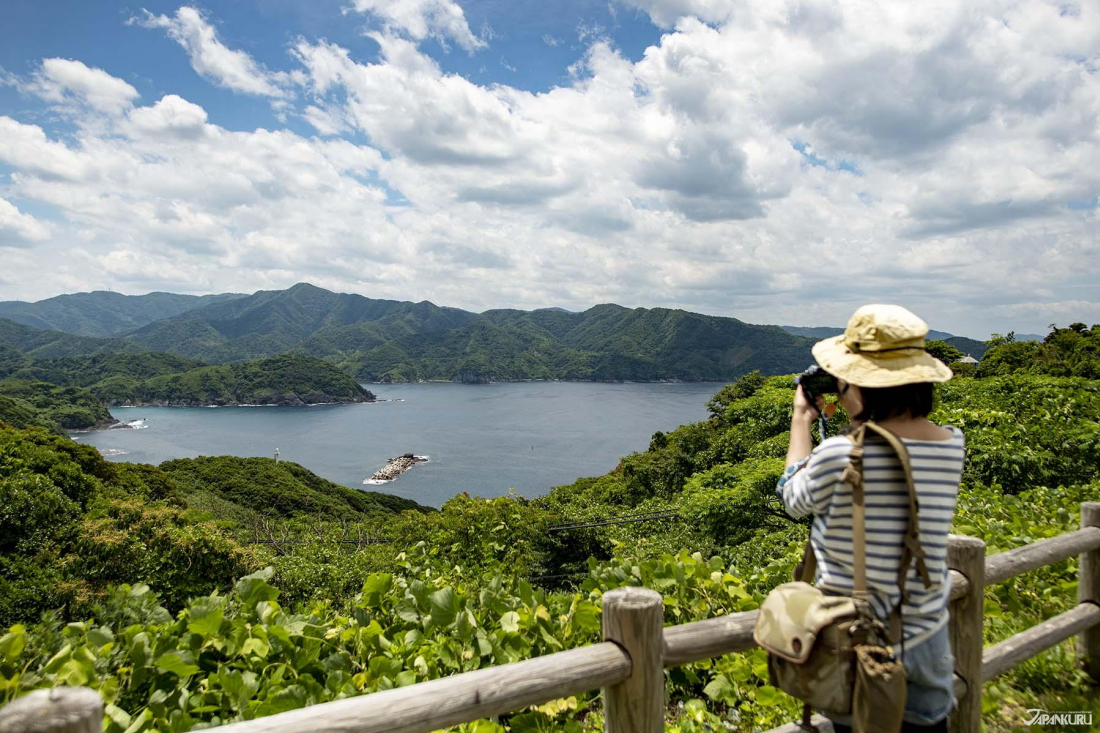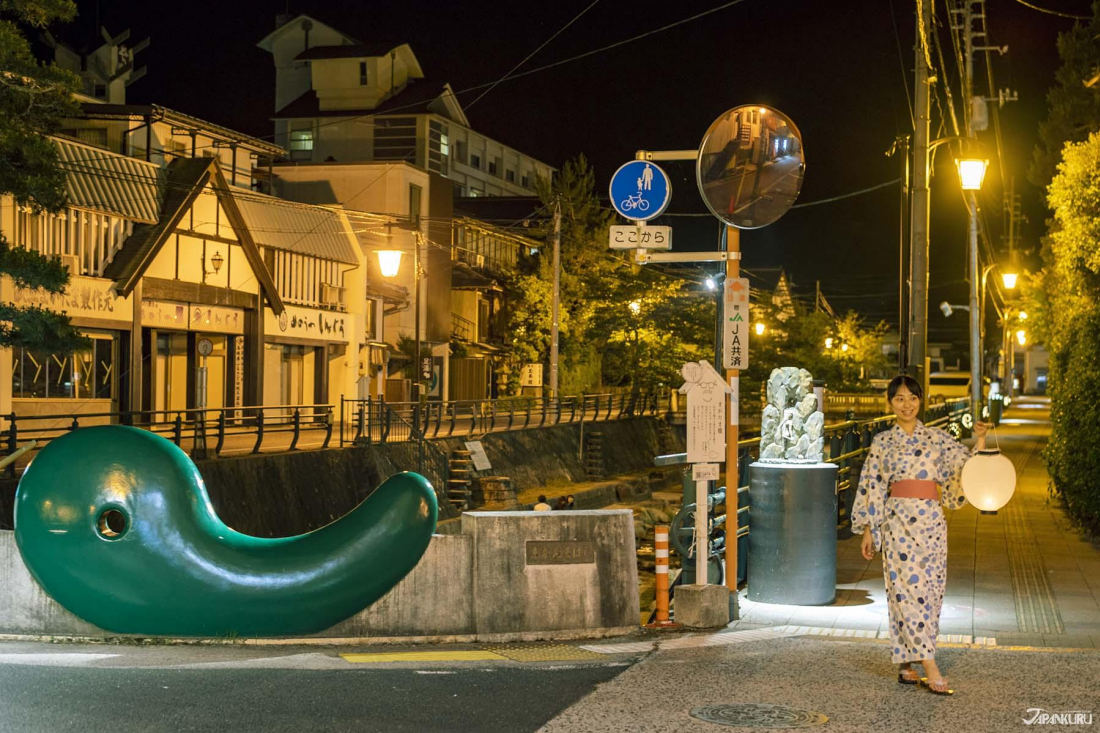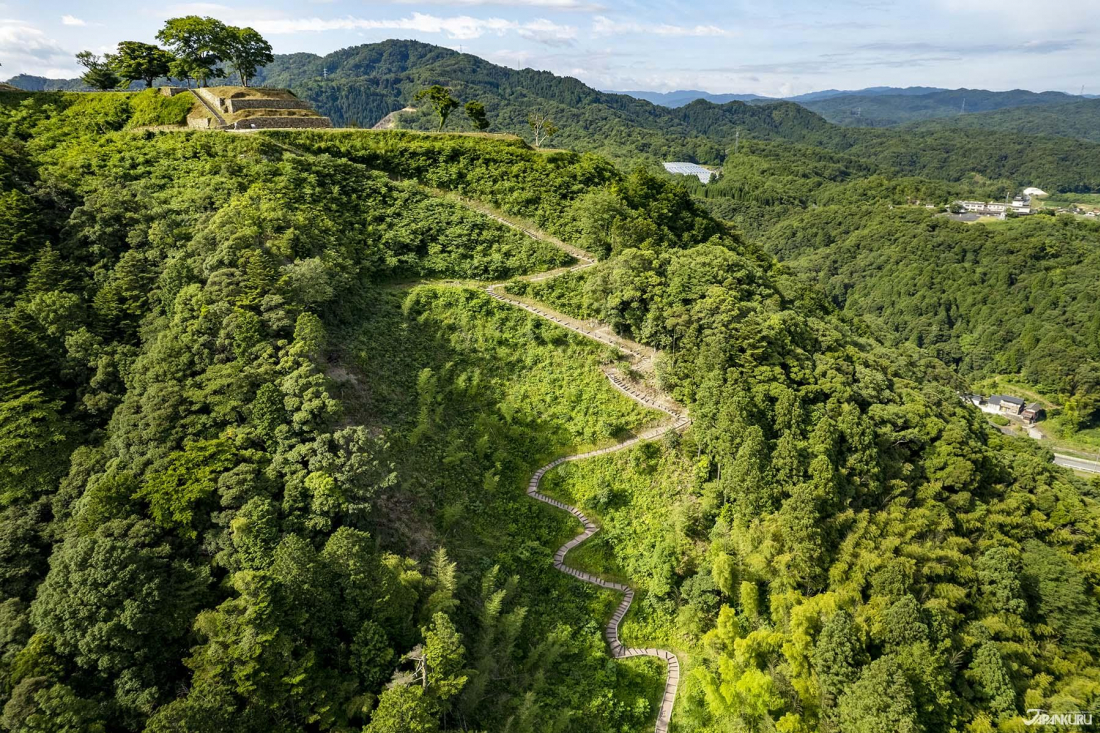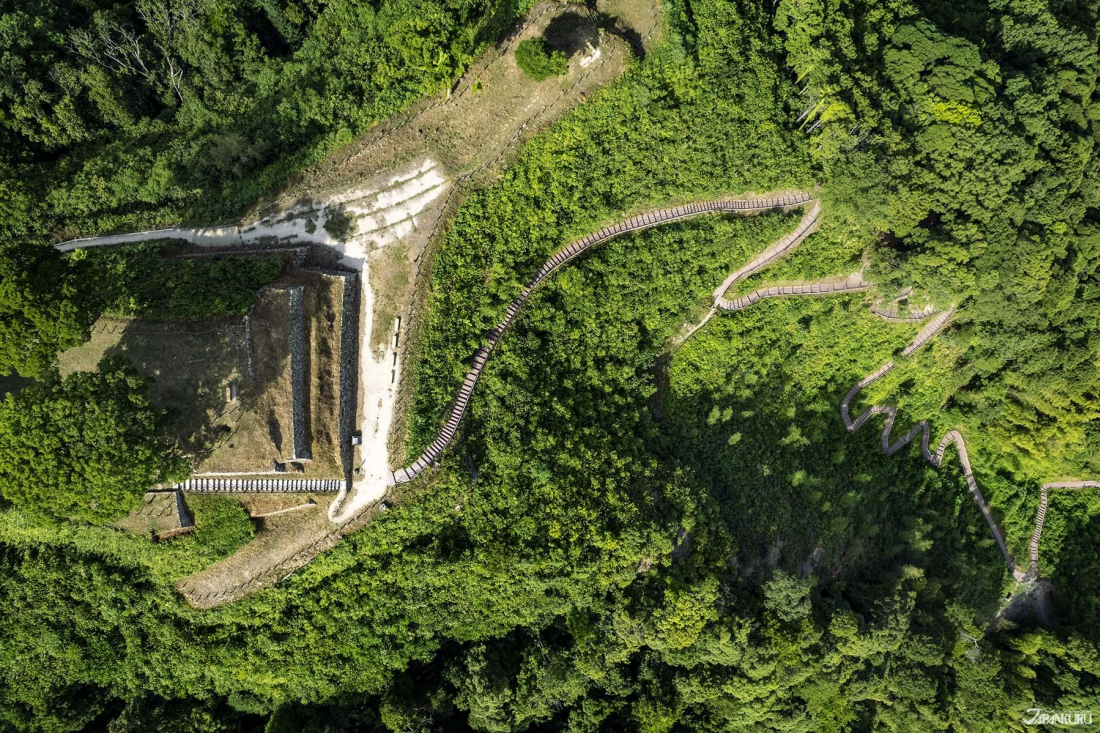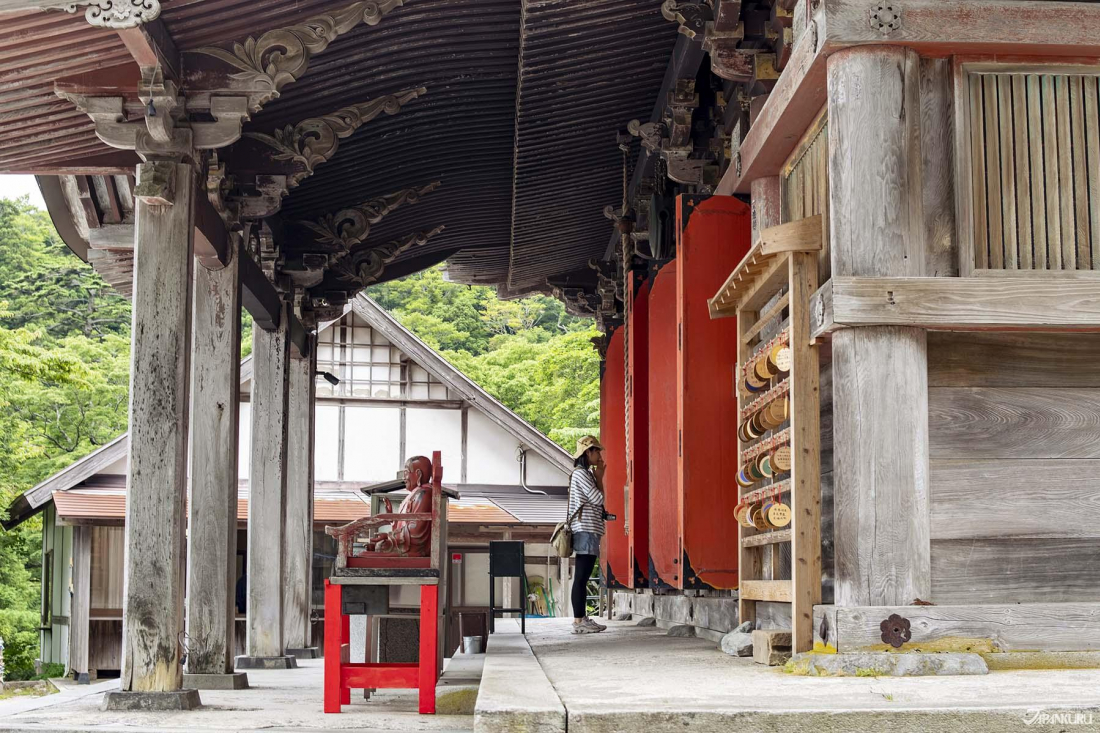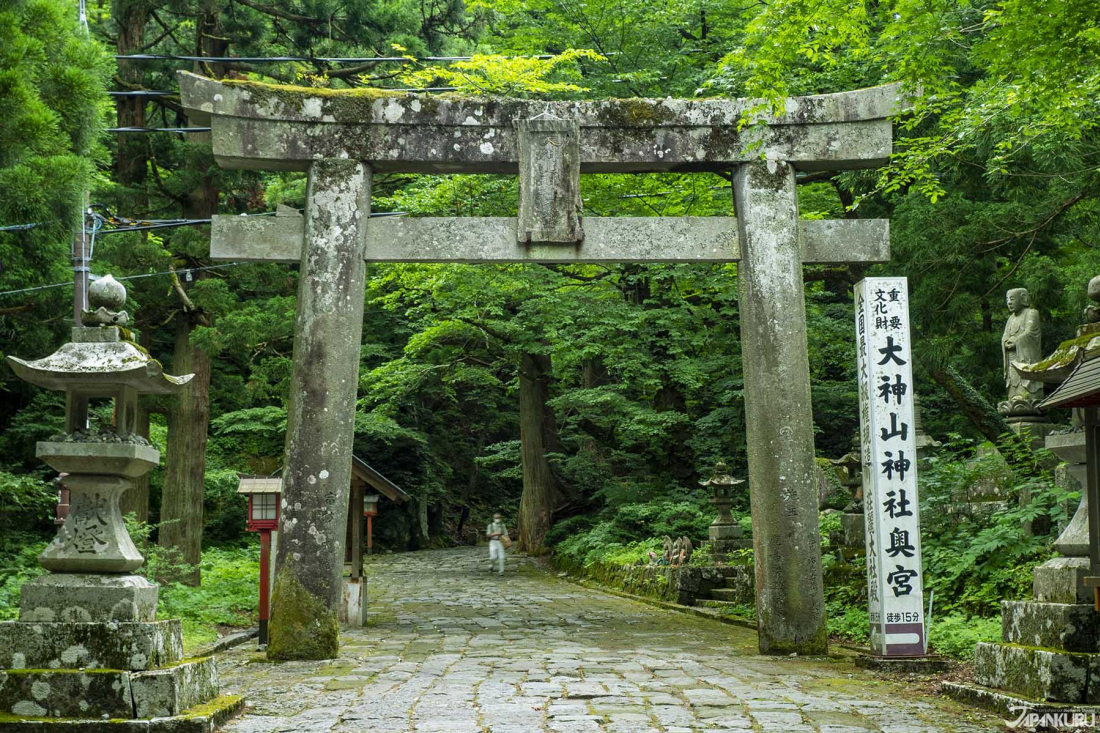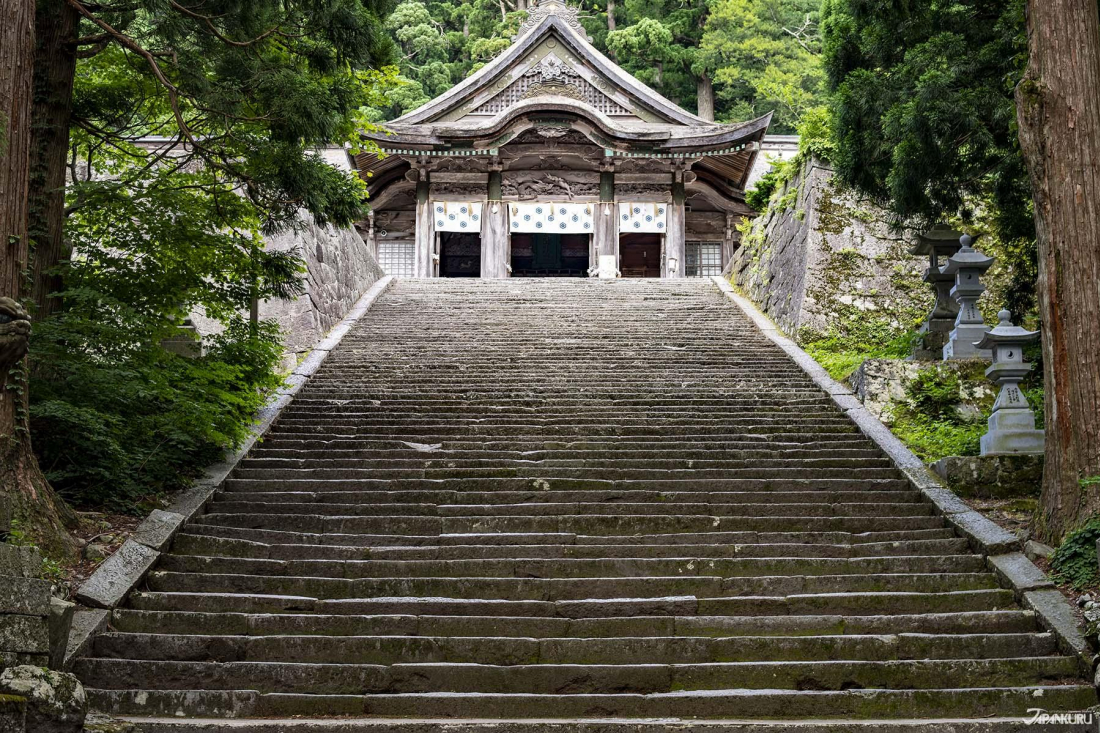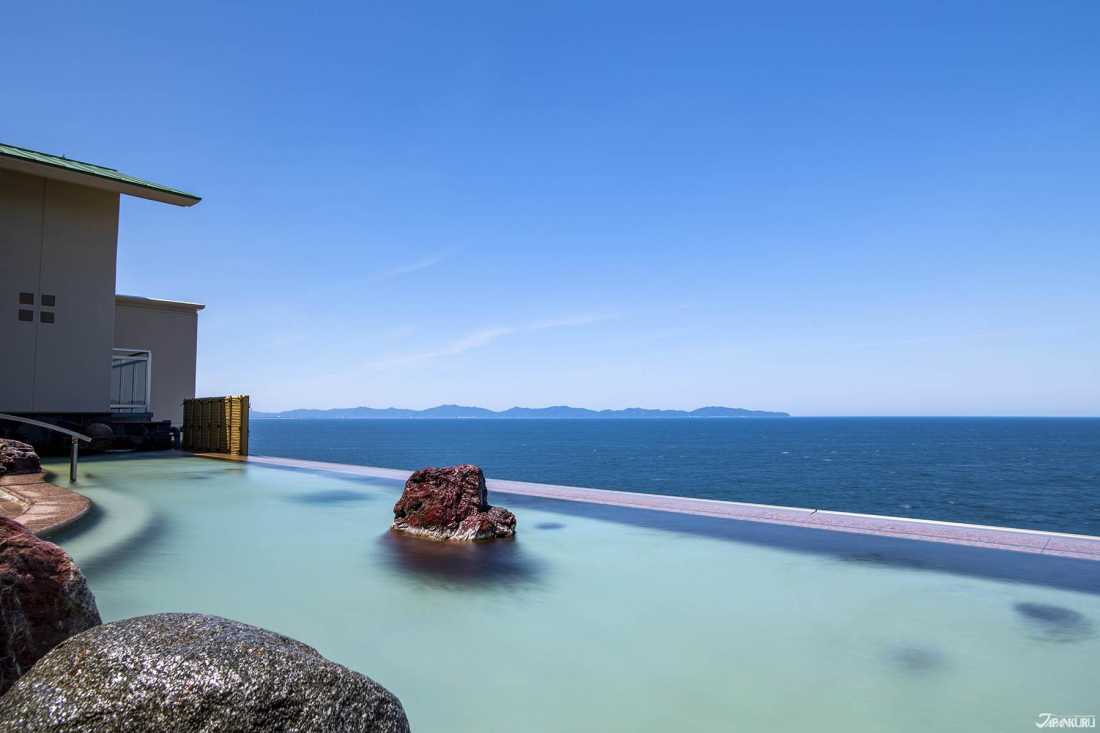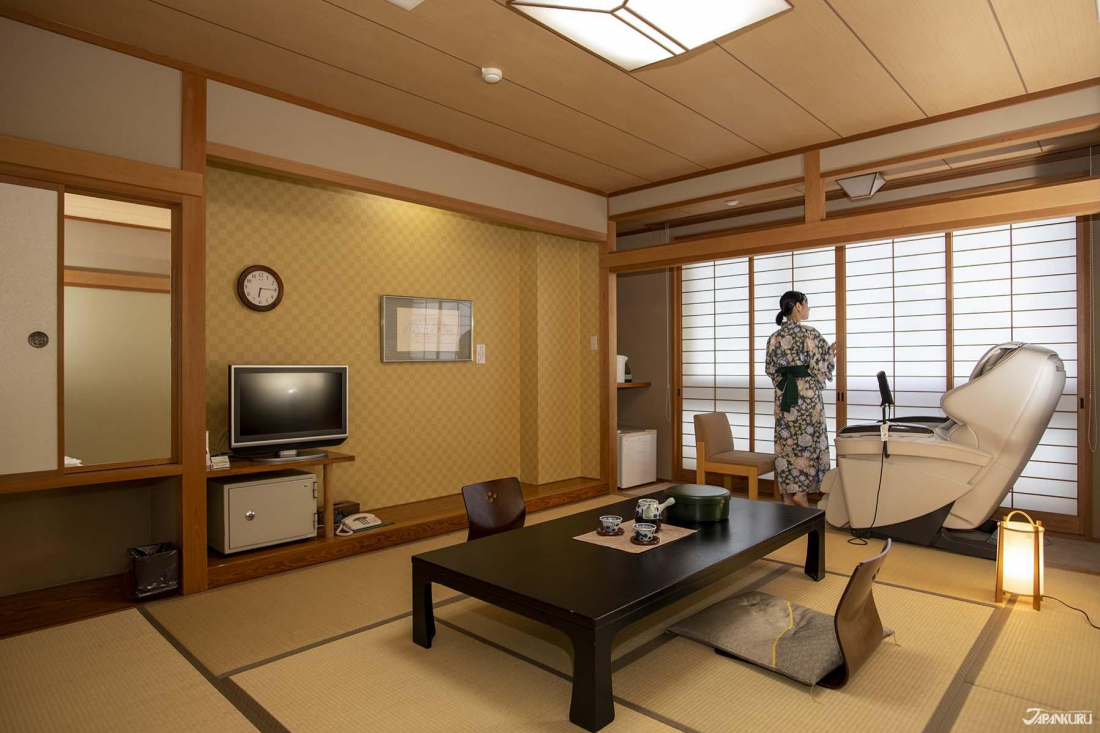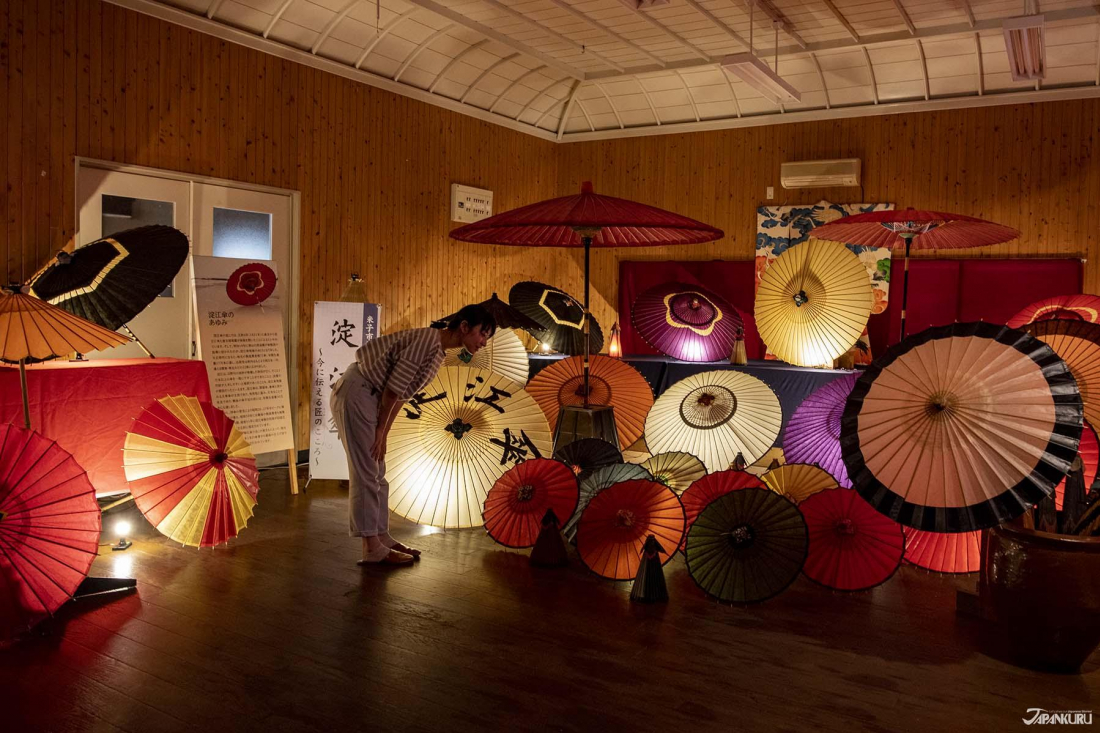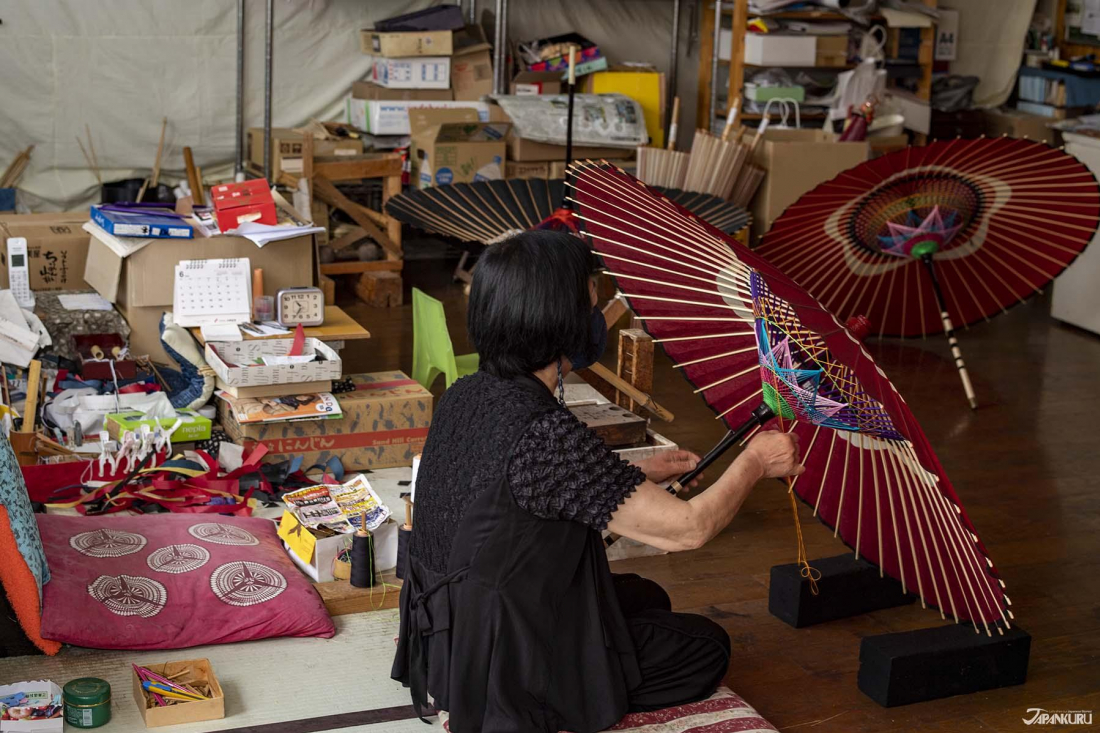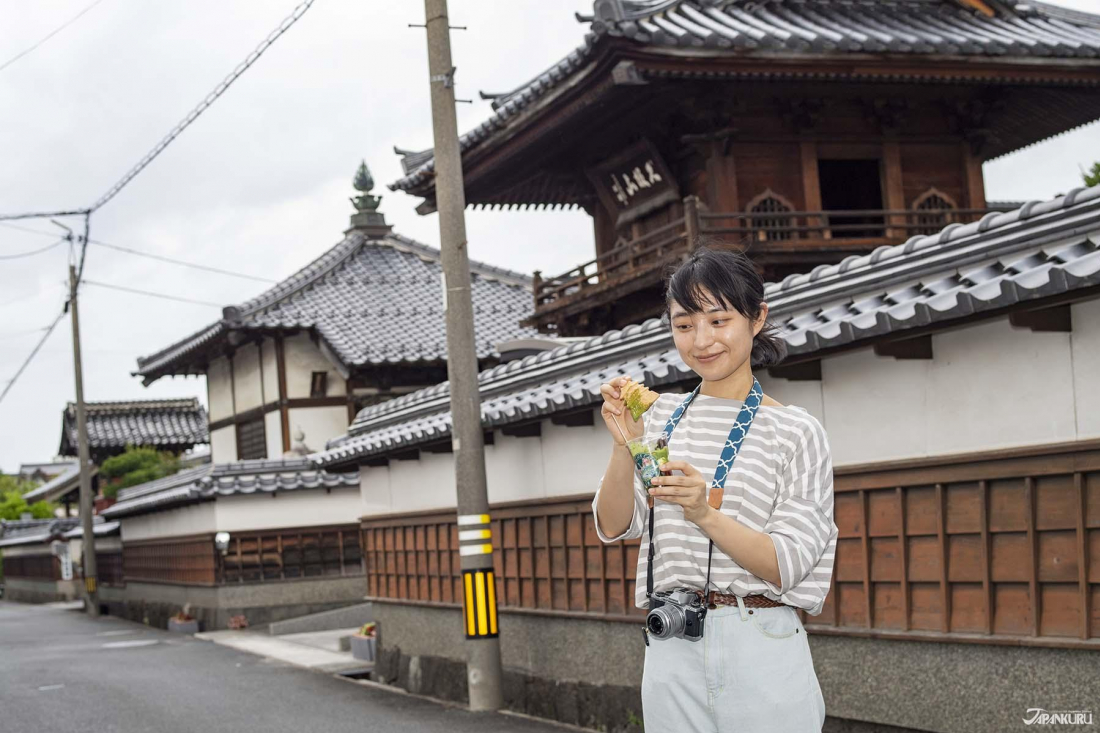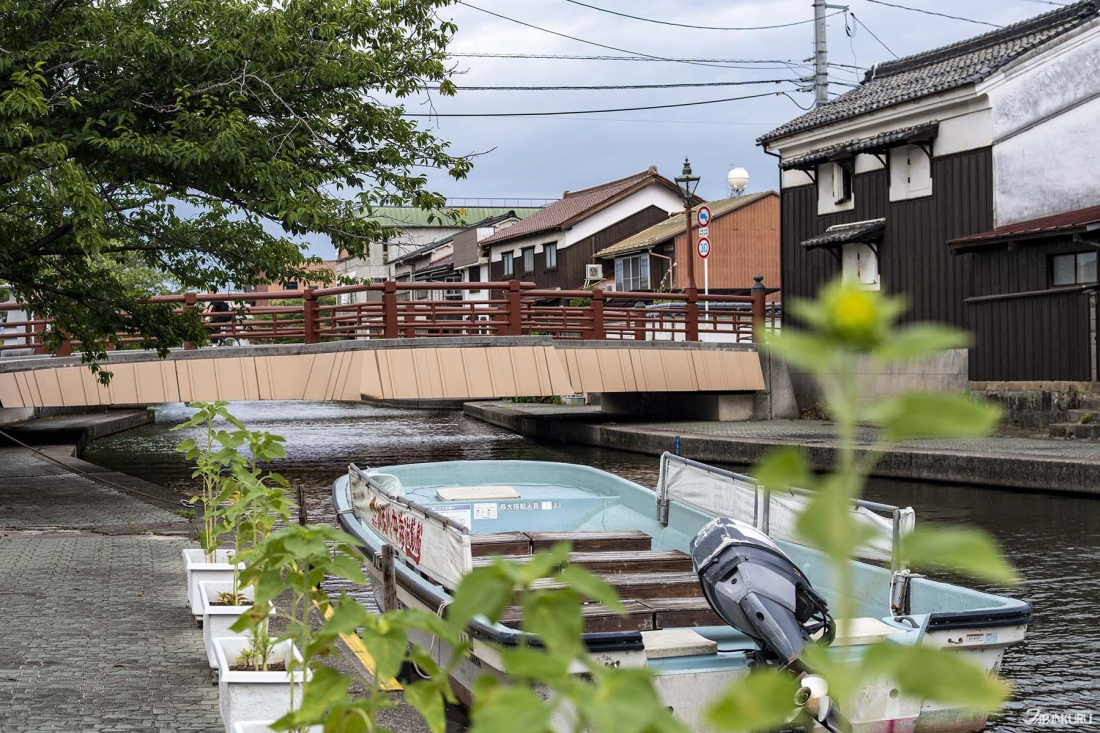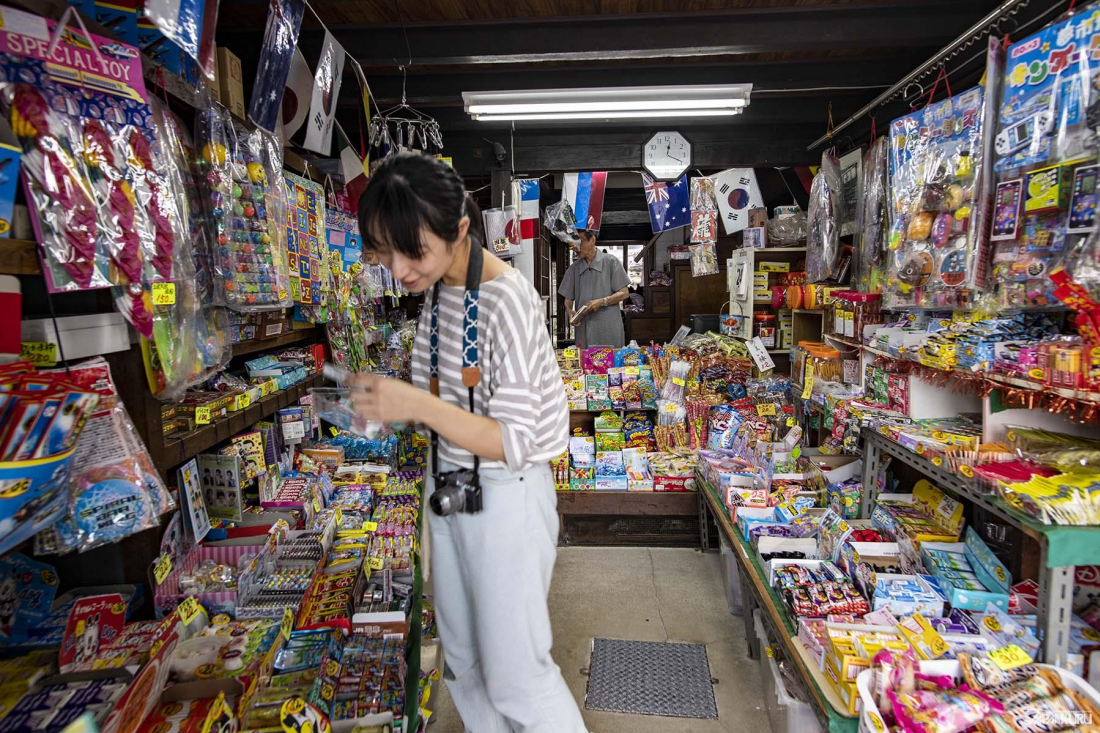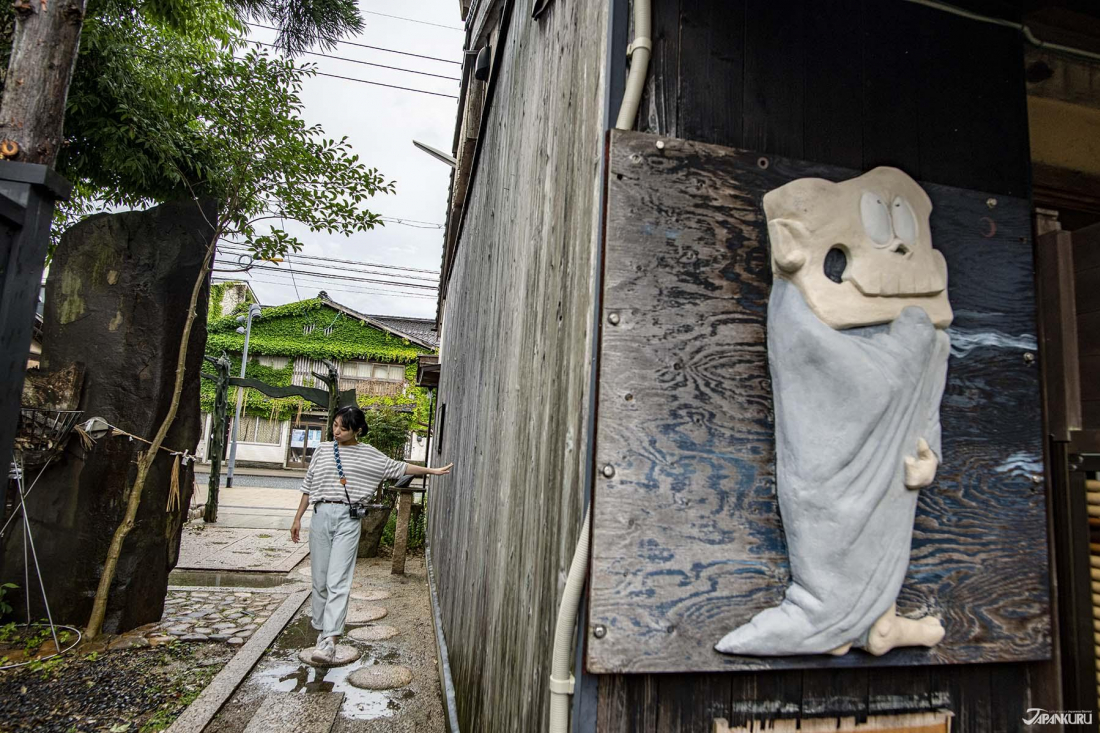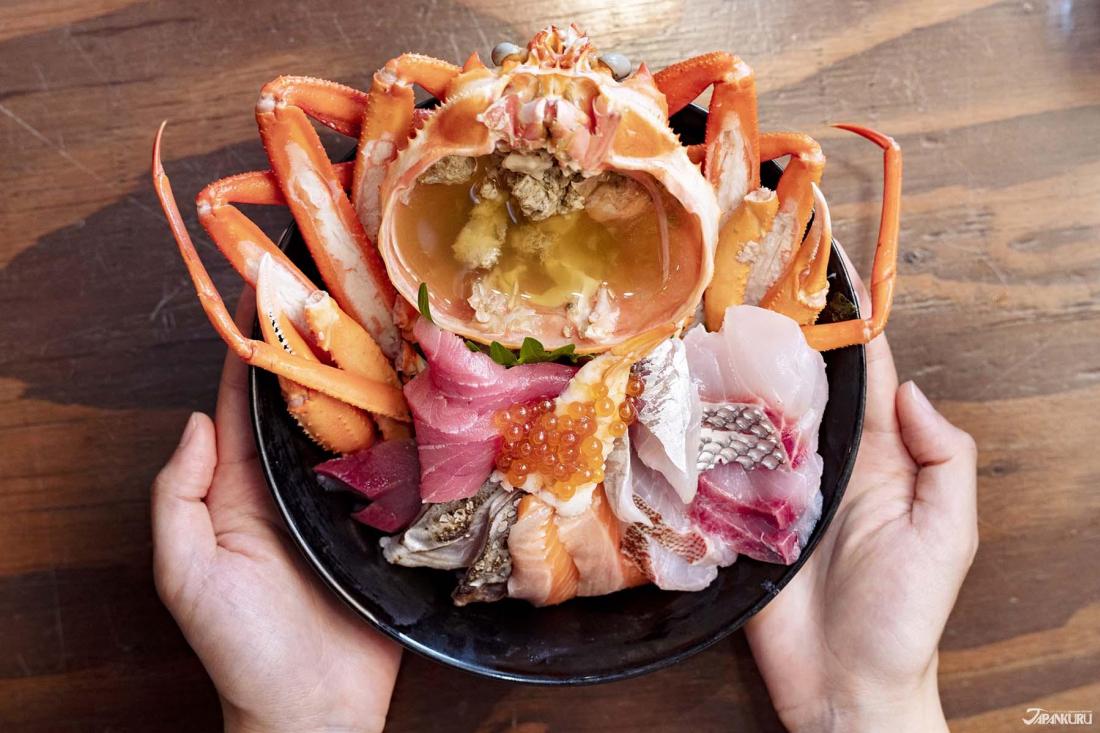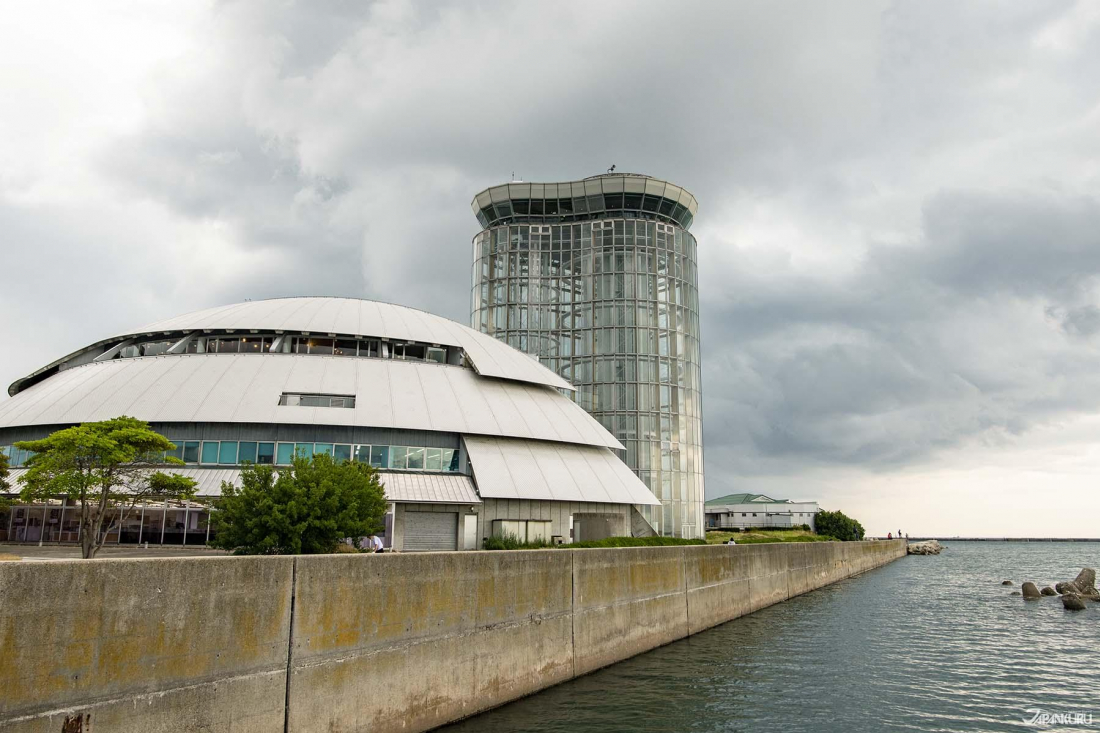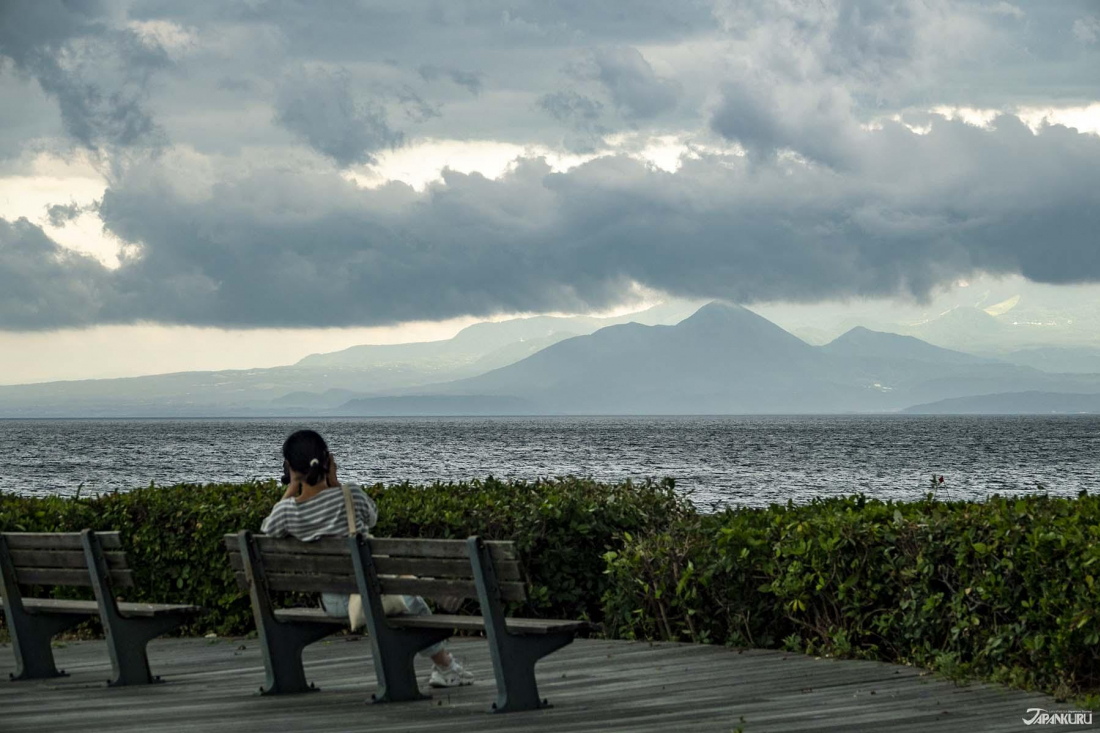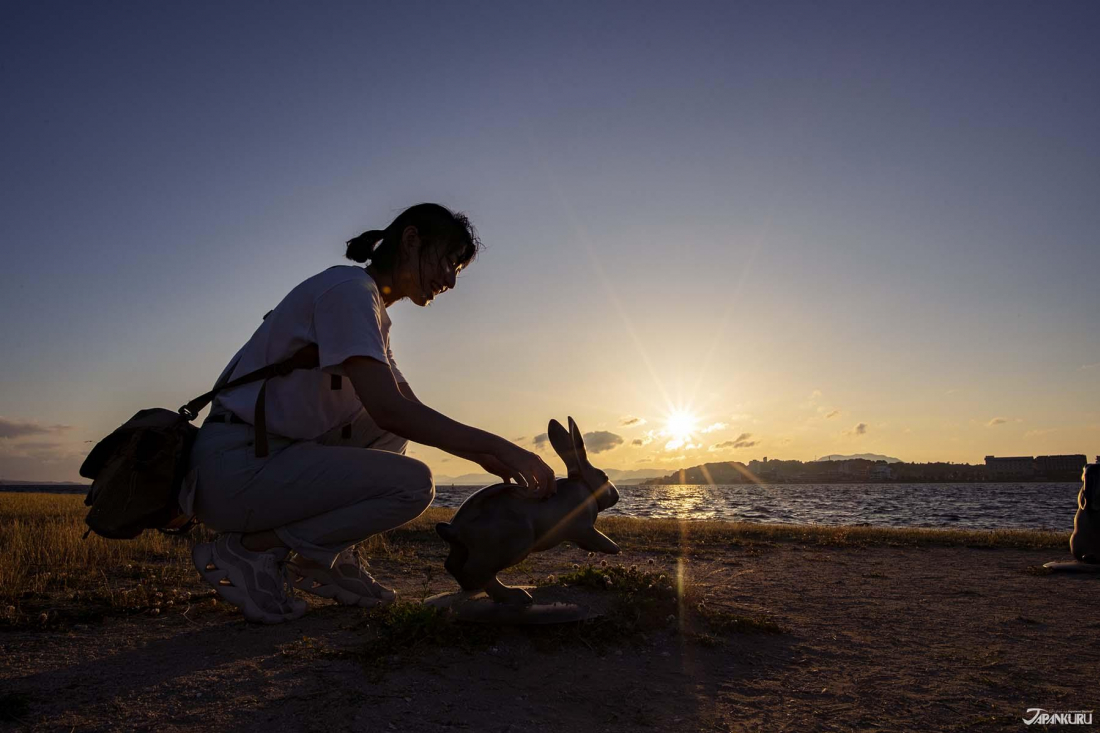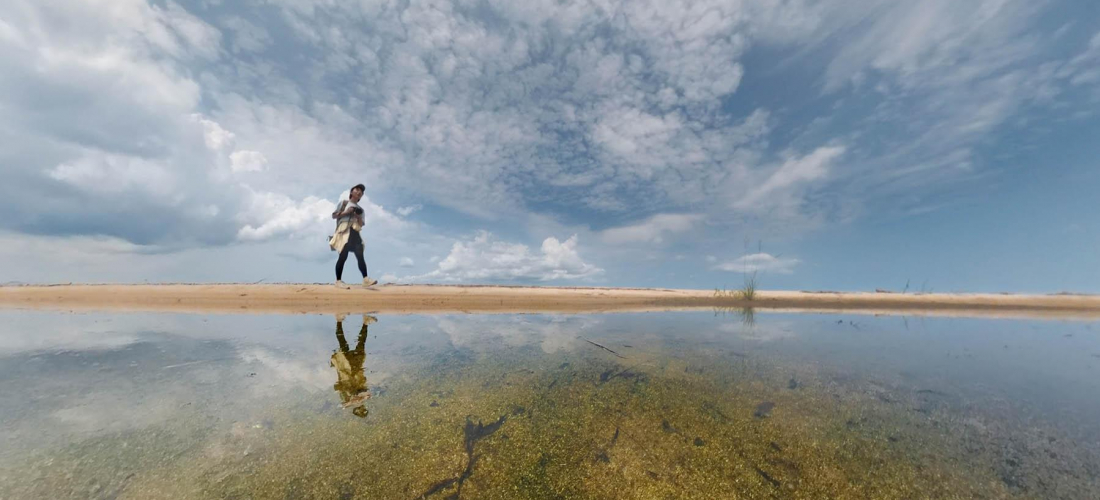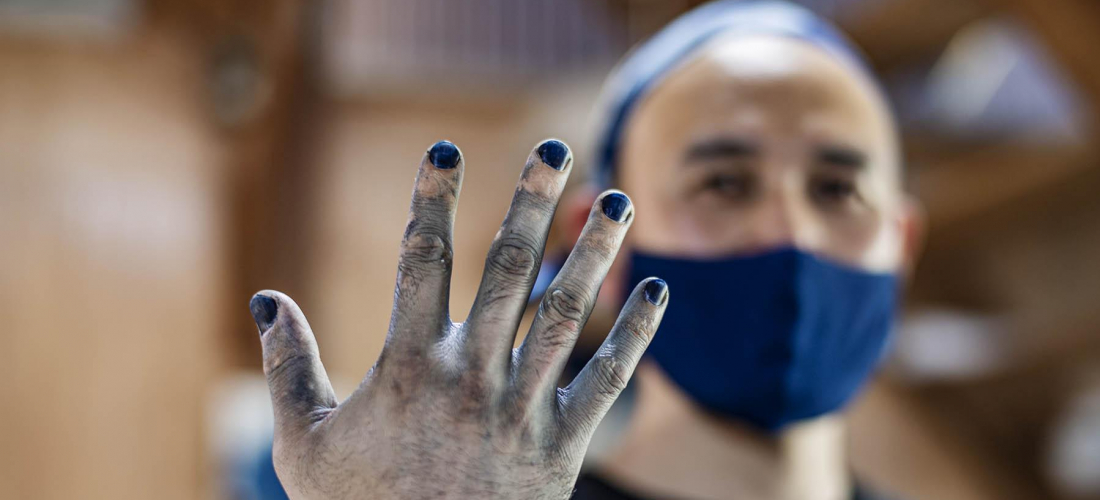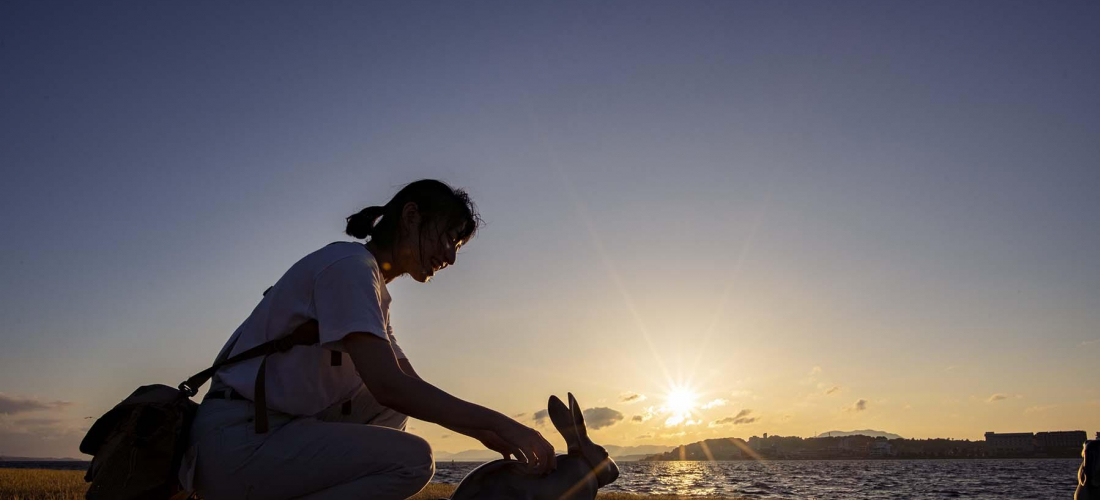
CONTENTS
Drive through the prefectures of Shimane and Tottori for a tour of central San’in and all its natural beauty.
Mountains, Lakes, and the Sea ・ A Land of Legends, Surrounded by Mother Nature
Look at a map of the Central San'in region, and the distinct landscape jumps out at you. With the sacred Mount Daisen at its back, San'in faces out towards the Sea of Japan, with Lake Shinji and the brackish lake Nakaumi shining like two blue jewels. This landscape has helped bring prosperity to the region, and San'in is resplendent with beautiful natural features, abundance, and local flavors as well. The area has long been home to Japan's oldest myths and stories, and many of those stories reference landmarks still found in the area, from long-preserved shrines and temples, to historical sites with more concrete pasts. These days, travelers come to San'in from near and far, to explore the local culture and beautiful scenery, and to search out the stories of old.
The cities of Izumo, Matsue, Yasugi, Yonago, and Sakaiminato are each landmarks in this area pressed between the mountains and the sea, each with their own unique sights and sounds. To see a little bit of each city, this time the Japankuru team set off on a road trip starting from Izumo Airport!
Have you read about our other trips to Central San'in yet?
San'in in 2020 | San'in in 2021
The Izumo Area
A Walk Through the Momen Kaido
Izumo is known as the "land of the gods," but one sign of the city being firmly rooted in reality is the charming old Momen Kaido (木綿街道), literally "The Cotton Road." It's said that local cotton was first processed and sold along this street back in Japan's Edo period (1603-1868), and the product eventually earned such a gleaming reputation that it was sold in big cities all over Japan. Later on, in the Meiji period (1868-1912), local cotton production slowed down as silk picked up, and mills opened to spin silky fibers into fine threads, attracting merchants to the area.
Many of the historic buildings are still standing along the Momen Kaido, giving the area a touch of old-fashioned charm, and giving it an atmosphere outside the normal flow of time. Duck into shops that have been selling their wares for centuries, or visit one of the many restaurants and shops that have been opened inside the old, preserved buildings.
Kurumaya Ginger Candy
The Kurumaya Ginger Candy Shop is one of the oldest shops doing business along the Momen Kaido, with a history of over 300 years, and an 11th-generation owner upholding centuries of family tradition. The shop still makes their ginger candies the traditional way, using just ginger, sugar, and water, and cooling the candies in old-fashioned copper plate molds to create simple sweets with a naturally delicious flavor. Even the design of the packaging remains unchanged! In addition to their classic candies, Kurumaya has started offering another option in more recent years, which they call the "Doctor's Prescription for Love" (恋の処方箋). These unapologetically adorable heart-shaped ginger candies come in a little paper bag that looks like a prescription for the heart, so you can give it to someone special – or maybe a friend suffering from heartbreak!
A trip to the Kurumaya Ginger Candy Shop doesn't have to just be about bringing home some tasty ginger drops. It's nice to simply hear all about the store's history, and enjoy the old-fashioned atmosphere full of retro candies. Plus, these natural hand-made sweets have a fresher, softer texture when they're just-made, so don't miss the one-of-a-kind chance to try them during your visit!
Kurumaya Ginger Candy Shop (来間屋生姜糖本舗)
774 Hiratacho, Izumo, Shimane
Hours: 9:00 – 19:00
Official Website (jp) | Official Instagram
Oka Moichiro Shoten
Another historical Momen Kaido shop is the Oka Moichiro Shoten, a soy sauce maker that has been selling the product for more than 120 years. The building looks, essentially, just like it did back in the Edo period, and it has a unique style of second floor peculiar to merchant houses of the era called a "tsushi nikai," with a strikingly low ceiling! The soy sauce is full of tradition too, and they specialize in a variety called "saishikomi" soy sauce (再仕込み醤油), brewed using a rare double-fermentation process, making a product prized in San'in and all the way down to Kitakyushu.
Oka Moichiro Shoten still brews their soy sauce in big wooden barrels, and visitors can call ahead to make reservations for a soy sauce brewery tour and check out what the behind-the-scenes of soy sauce making really looks like. The brewery also offers soy sauce tastings for all the different varieties they make, so visitors can hear all about Oka Moichiro soy sauce from Shigeru Oka (the 8th generation owner), and then sample all the subtle flavor differences. Their saishikomi soy sauce ice cream is also a must-try for any sweet-tooth visiting the Momen Kaido!
Oka Moichiro Shoten (岡茂一郎商店)
861 Hiratacho, Izumo, Shimane
Hours: 9:00 – 19:00 (closed Tuesdays)
Official Website (jp)
Karakama Shrine
High in the mountains, uphill from the famous autumn leaves of Izumo's Gakuenji Temple, is a Shinto shrine that has long been hidden away in the woods: Karakama Shrine. Tucked in among the cedars, in a secluded little spot (with extremely poor reception), a long set of rugged stone steps leads up the mountain to a narrow stone crevice. Just a sliver of sky is visible through the rock faces, a little like the entrance to another world. It's a popular local "power spot" said to relieve worries and anxiety, and people also come looking for help growing their families. Each visitor is born from the stone as they carefully edge sideways through the tight path.
Karakama Shrine was established so long ago that the exact origins are hard to nail down, but its presence in ancient legends makes it clear that it's been around for quite a while. The shrine's name literally means something along the lines of "Korean stove," referencing the sea crossing of the enshrined deity Susanoo-no-mikoto and his son Isotakeru-no-mikoto, who brought back forestry techniques and the culture of ironware from the Kingdom of Silla, on the Korean peninsula.
Karakama Shrine (韓竈神社)
408 Karakawacho, Izumo, Shimane
Official Page (jp)
The Matsue Area
Karakoro Art Studio
Housed in the former 1930s Matsue branch of the Bank of Japan, Karakoro Art Studio opened in the spring of 2000 as an "artisan house," where visitors can check out boutiques, eateries, and workshops for everything from art to accessory making, traditional crafts, cooking, and more – including traditional Japanese wagashi sweets classes, or natural stone accessory making! The retro building is a design from architect Uheiji Nagano, who designed a number of notable former Japanese Bank buildings and even Taiwan's Office of the President, but these days the facility's courtyard becomes a special destination during tsuyu, the Japanese rainy season. The space is turned into the "Enishizuku Umbrella Sky" for just a handful of weeks each year, when Karakoro Art Studio turns rainy day sunlight into rainbows with more than 200 colorful transparent umbrellas overhead.
Perfect for travelers who like to snap (and share) lots of pictures, Karakoro Art Studio has plenty of photo spots, like the lucky pink mailbox out front. Visitors can even visit the former bank vault in the building's basement! There aren't any piles of riches left in the vault these days, unless you count the art and exhibitions sometimes displayed in the space, but you can pick up a pile of replica 10,000 yen bills to see how much it would way down your pockets if you won the lottery. This armful adds up to 100 million yen!
*Karakoro Art Studio will be closed temporarily for repairs in 2023, and is expected to open again in 2024.
Karakoro Art Studio (カラコロ工房)
43 Tonomachi, Matsue, Shimane
Hours: Workshop 9:30 – 18:30 | Restaurant 11:30 – 18:30 (closed 12/30~1/1)
*Individual business hours may vary, please check the official website before going.
Official Website (jp)
Shimane Art Museum
The Shimane Art Museum is perched right on the shore of Lake Shinji, the setting for one of the "100 Best Sunsets in Japan," and the museum is a particularly popular viewing location. The C-shaped building has a wall of floor-to-ceiling windows, and the vast panes of glass let the glow of the sunset shine into the museum each evening as one enormous natural work of art. Of course the sunset isn't the only art found at the Shimane Art Museum, and even outside on the lakeshore there are sculptures scattered around the grassy trails, but it is known as the "sunset museum," and visitors frequently arrive to take photos of the museum, its art, and the sunset from every angle. The museum even adjusts closing times to accommodate the natural cycle of the sunset.
The museum collection encompasses more than 7,000 works, including paintings, sculptures, industrial crafts, photographs, and more from artists around Japan and abroad. Ukiyo-e lovers will be particularly dazzled by the Shimane Art Museum's collection of almost 3,000 pieces from famous artists like Katsushika Hokusai, Utagawa Hiroshige, and more.
Shimane Art Museum (島根県立美術館)
1-5 Sodeshicho, Matsue, Shimane
Hours: Oct~Feb 10:00 – 18:30 | Mar~Sep 10:00 – 30 min after sunset (closed Tuesdays/year-end holidays)
Official Website (en)
Marine Park Takobana
At the very northernmost tip of the Shimane Peninsula is a promontory that slopes up into the heavens, called the "Cape in the Sky." The Takobana area is full of complicated terrain thanks to its formation as a deeply indented Rias coastline, and in 2004 seaside resort Marine Park Takobana opened on the cape to help travelers enjoy the unique natural beauty. Now a line of simple two-story cabins snakes along the edge of the promontory, each one with a magnificent sea view, along with convenient shared facilities like a barbecue area and a camping site. (Barbecue and camping gear is available for rent!)
One of the most popular spots at the resort is the observation platform, where you can feast your eyes on a panoramic view of Takobana's verdant forested coastline. Anyone, resort guest or not, can climb up and enjoy the view from the observation platform, but visitors who stay the night have the luxury of looking out at the blue sea as the sun sets, the clear starry night after dark, and the pale dawn as the sun rises in the east. It's a romantic spot, and many couples like to leave their own "lovers' lock" behind, including local sweethearts.
Marine Park Takobana (マリーンパーク多古鼻)
1050 Shimanecho Tako, Matsue, Shimane
Official Website (en)
*Onsen Recommendation*
Tamatsukuri Onsen
Looking for a little rest and relaxation around Matsue? This hot spring has been around since Japan's Nara period (710-794), and it's earned a reputation as a "hot spring of the gods." The onsen owes its popularity in part to a feudal lord from the Matsudaira clan, who came to convalesce at Tamatsukuri during the Edo period, starting a trend that lasts to this day. The name Tamatsukuri (玉造) refers to working with precious stones, uncommon for a hot spring, but the region was once known for crafts made with stone agate mined from nearby Mt. Kasenzan, including a part of the Imperial Regalia!
The area is known for old-fashioned Japanese ryokan hotels with traditional architecture, large open-air baths surrounded by beautiful gardens, and connections to Japanese mythology. Even visitors just dropping by can take a moment to enjoy the warm hot spring water at the natural foot bath along the Tamayu River, while looking out at the mountains in the distance.
Tamatsukuri Onsen (玉造温泉)
255 Tamayucho Tamatsukuri, Matsue, Shimane
Official Website (jp)
The Yasugi Area
Gassantoda Castle Ruins
If you've ever played a Japanese video game that harkens back to history, particularly Nobunaga's Ambition or Samurai Warriors, then you might know the name of the great commander Yamanaka Yukimori and the Amago clan, or even Gassantoda Castle itself, where they spent their time. The massive scale and strong defenses of Gassantoda Castle gave it a reputation as an impregnable fortress – an important stronghold for the Amago clan as they conquered the San'in and Sanyo regions during the Sengoku/Warring States period (1467-1568).
As the years passed, Gassantoda Castle eventually fell into ruin, leaving only remnants in its mountaintop clearing. But a road still leads up to where the castle once towered above its territory, 190m (623ft) above sea level. Looking out over the old castle walls, you can almost imagine yourself as part of the Amago clan during their battles for the San'in and Sanyo regions, fighting alongside Yamanaka Yukimori half a millennium ago. The area now has a statue commemorating the commander, and a memorial tower as well.
Gassantoda Castle Ruins (月山富田城跡)
Hirosecho Toda, Yasugi, Shimane
*If using a car navigation system, please search for the Yasugi City History Museum (安来市立歴史資料館).
Official Page (jp)
Yasugi-Kiyomizudera Temple
Yasugi-Kiyomizudera Temple is deep in the mountains, with a long path approaching the main temple building, and lush forest lends the grounds a calm, tranquil atmosphere. Walking along the quiet trails, it's hard to believe that the temple was once a battleground for the war between the Amago and Mori clans during the Sengoku period. The temple has been around since long before those days, though, and can be traced back as far as the year 587, to the Kofun-era high priest Sonryu. According to legend, the temple's 1420-year history began in a place where ancient pines grew thickly and towered overhead, and visitors to the area often found themselves uneasy in this remote wilderness. Once the temple monks built their first thatched huts and enshrined an image of the Buddha, they went on to search for a water source, despite water being rare on the mountain. Miraculously, they found a fresh spring right next to a hut, giving the temple the name "Kiyomizu," which means pure water.
Back when the temple was constructed, it didn't clearly belong to any particular Buddhist sect, but during the Heian period (794-1185) the priest Ennin (also called Jikaku Daishi) brought Tendai Buddhism to Yasugi-Kiyomizudera Temple from Mount Hiei in Kyoto. It's now one of 33 sacred sites of the Kannon bodhisattva in the Chugoku Region. With its millennium-and-a-half history, and its grand but simple monastery architecture (the only one of its kind in the region), Yasugi Kiyomizudera Temple has a majestic atmosphere worth experiencing. The grounds also include a Shinto shrine to the god Inari, with all its many red gates, and beautiful hydrangeas that bloom nearby, in addition to an observation deck at the back of the temple with a fantastic view of the Nakaumi and Mount Daisen. Visitors can enjoy the beauty of Japan while visiting one of Chugoku's sacred Kannons.
Yasugi Kiyomizudera Temple (安来清水寺)
528 Kiyomizucho, Yasugi, Shimane
Official Website (jp)
The Daisen Area
Daisenji Temple
Mount Daisen has been a sacred place since ancient times, and there's evidence of worship going back 1,300 years, but the Buddhist priest Konren officially established Daisenji Temple in Japan's Nara period (710-794). The temple later became part of the Tendai sect in the Heian period, and through the Kamakura period (1192-1333) and Muromachi period (1336-1573), the temple saw peace and prosperity. As a result, Daisenji Temple was compared to Kongobuji Temple on Mount Koya in Wakayama, or Mount Hiei's Enryakuji, and said to be home to 3,000 warrior monks.
Daisenji isn't quite so lively these days, and the temple has been trimmed down to just four worship halls and ten courtyards, but the venerable grounds and ancient atmosphere remain. The huge gate remains scarred but standing on the temple approach, and many visitors also come to enjoy the surrounding mountain greenery, and the neighboring Ogamiyama Shrine. In the fall, the spot is known for its beautifully colorful foliage!
Daisenji Temple (大山寺)
9 Daisen, Saihaku District, Tottori
Official Website (jp)
Ogamiyama Shrine Okunomiya
Mount Daisen has been a sacred mountain for the people of San'in for as long as anyone can remember, so Ogamiyama Shrine was established to honor the "great god mountain." The shrine's two major shrine halls are both dedicated to the god Okuninushi, a god of industry and prosperity, abundant harvests, horses, cattle, magic, medicine, and warding off evil as well.
The main shrine hall at the foot of the mountain is a famous spot for hydrangea viewing in June, while the okunomiya (inner or rear shrine) is hidden away deeper in the mountain, although people make the trek to visit this famous power spot. The 700m approach, set with stone, is the longest of its kind in Japan, but towering trees make the hike a pleasant one, and at the end of the path an ancient gate leads to a grand set of steps, and the largest gongenzukuri-style shrine building in Japan. Ogamiyama Shrine also has ceilings covered in beautiful circular paintings, and the largest scale work of sandalwood lacquer in Japan. The natural stone road, the grand gongenzukuri-style shrine hall, and the sandalwood lacquer work are said to be "the three #1s" of Ogamiyama Shrine.
Travelers considering a trip to the shrine should keep in mind that the mountain weather is prone to change, which can make the area inaccessible. Always check the Daisen Drive Navi to check conditions before heading out!
Ogamiyama Shrine Okunomiya (大神山神社奥宮)
1 Daisen, Saihaku District, Tottori
Official Website (jp)
*Onsen Recommendation*
Kaike Onsen
After a day hiking through Yasugi or Daisen, Yonago's Kaike Onsen is the perfect area to spend the night, thanks to the ultra-relaxing resorts of this seaside hot springs zone. The onsen baths of Kaike Onsen are particularly hot and high in sulfur, making them good for relieving aching feet, but locals also swear by the waters for more chronic pain. There's nothing more relaxing than soaking away in the steaming waters of an outdoor onsen, looking out at the blue ocean waters, and listening to the waves crash below.
Even if the luxurious ocean-view baths of an upscale seaside onsen ryokan are out of your budget for this trip, Kaike Onsen still offers the simple pleasures of a good onsen bath, a comfy hotel yukata, and a walk along the beach! On this trip the San'in, the Japankuru team stayed in the cozy Ikoitei Kikuman Ryokan, which has a modern Japanese-style lobby, and massage chairs inside the Japanese rooms. Unlike many ryokan, the hotel yukata at Ikoitei Kikuman come in a variety of designs, and you can wear your favorite while you relax around the hotel.
Ikoitei Kikuman Ryokan(温泉旅館 いこい亭 菊萬)
4-27-1 Kaikeonsen, Yonago, Tottori
Phone: 0859-38-3300 (available 9:00 – 21:00)
Check-in/Check-out: 15:00 – 19:30 / ~10:00
Official Website (jp)
Kaike Onsen is full of luxurious baths, and the sandy beaches glow as the sun sets, glitter under a starry sky, and provide a perfect place for early-morning walks as the sun rises. A handful of restaurants by the beach also offer outdoor seating, perfect for enjoying the warm summer weather and a cool sea breeze.
Kaike Onsen (皆生温泉)
Kaike Onsen, Yonago, Tottori
Official Website (jp)
The Yonago Area
Yodoe Japanese Umbrella Museum
The Yodoe area of Tottori was once one of just a few areas around Japan that specialized in crafting traditional washi umbrellas, and in the golden age of umbrella production, rows of colorful paper umbrellas could be seen spread out to dry on the sandy beaches of the nearby Hino River. Although clear vinyl umbrellas have mostly taken the place of traditional paper ones in the daily lives of people in Japan, the artisan craft of Yodoe umbrellas is still passed down in the region, and the Yodoe Japanese Umbrella Museum is at the forefront of preserving the beauty of this tradition.
Yodoe umbrellas are made from local bamboo and San'in's famous Inshu washi, making them both classically elegant, and also impressively waterproof. Whether you want to call the end result a high-end product or a work of art, these traditional umbrellas have been favorites of Japan's upper crust for a long time, and one has even been presented to Princess Kako.
Visitors to the Yodoe Japanese Umbrella Museum can not only watch generations of crafting tradition put to work right before their eyes, but also check out interesting exhibitions like umbrella light displays, and plenty of finished umbrellas to ooh and ah over – big and practical, or small and decorative.
Yodoe Japanese Umbrella Museum(淀江和傘伝承館)
796 Yodoecho Yodoe, Yonago, Tottori
Hours: 9:00 – 17:00 (closed Sun/Mon/holidays)
Official Website (jp)
Sightseeing in Kamogawa & Around the Nakaumi
The Kamogawa and Tenjin Bridge area of Yonago was once part of a busy castle town, with boats and their cargo coming and going on the canal. These days the area is a little sleepier, but it's still crowded with old-fashioned houses and white-plastered Japanese warehouses along the water, along with Teramachi Street/Otera Ginza (寺町通り/お寺銀座), which is home to nine different old temples (tera/otera in Japanese).
The Kamogawa River is popular as a spring cherry blossom destination, and one of the best ways to enjoy the cherry trees is a riverboat cruise along the river and the Nakaumi. The river is also home to a number of mythical kappa, including creations by the mangaka Mizuki Shigeru, known for his manga Ge Ge Ge no Kitaro, which focuses on the traditional Japanese mythical creatures called yokai.
Okamoto Issen-ya
A retro snack shop in the old-fashioned district of Kamogawa, Okamoto Issen-ya offers customers a wide range of classic treats, and they've been at it for more than 70 years. The name "issen-ya" implies that the store's wares can be bought with small change, and the huge copper coin sign out front was made in 1950 to commemorate the Yonago Fair. Okamoto Issen-ya has always catered to little kids with a few coins and an appetite, and the colorful little space is crowded with nostalgic sweets and unique snacks.
Okamoto Issen-ya is popular with local children and adults, and the shop attracts quite a few nostalgia-seeking sightseers as well. The old-fashioned building and toys are a treat, but the real charm comes from Ms. Okamoto, who still runs the shop with a cheerful smile. Even when traveling far from home, a chat at Okamoto Issen-ya feels like chatting with a friendly neighbor!
Okamoto Issen-ya (岡本一銭屋)
1-4 Tatemachi, Yonago, Tottori
Official Website (jp)
Nagacha Cafe 1801
The Nagata tea shop has been in business for 220 years, specializing in authentic Japanese tea grown organically or with low levels of pesticides, and the main shop in the Kamogawa River area has long been a go-to for Yonago souvenirs. Since 2019, the old shop has been taking on the world of modern sweets as well thanks to a public fundraising effort, with their new takeout cafe Nagacha Cafe 1801. The menu is full of sweets that make the most of the shop's high-quality Japanese green tea/matcha, definitely worth a taste for those exploring the area.
Out of all the tempting tea-based items, some of the most popular are the tiramisu-like chabatake latte (茶畑ラテ/tea field latte), and the 475 parfait, which comes with its own little mini Yonago Castle. Why 475? With a little finagling, the numbers 4-7-5 can be pronounced "yo-na-go" in Japanese! The shop also has lunch specials on Mondays, Thursdays, and Fridays (11:00 – 13:00), so stop by if you're looking for some tasty bites.
Nagacha Cafe 1801(長田茶店 岩倉町本店)
76-2 Iwakuramachi, Yonago, Tottori
Hours: 11:00 – 17:00 (closed Wed)
Official Website (jp) | Official Instagram
The Sakaiminato Area
Mizuki Shigeru Road
Knowledgable anime fans might know that Tottori Prefecture is home to Detective Conan (AKA Case Closed), but the city of Sakaiminato is also the hometown of Ge Ge Ge no Kitaro author Mizuki Shigeru, and Mizuki Shigeru Road is a "yokai street" that stretches 800 meters east from Sakaiminato Station. The area includes fun yokai spots like the Yokai Shrine, the entertainment-focused Yokai Rakuen, and the Mizuki Shigeru Museum, too. Retro souvenir shops and coffee shops line both sides of the road, along with 177 yokai just waiting to say hi. You don't have to be a Ge Ge Ge no Kitaro fanatic to enjoy this fun destination!
Mujara Handicrafts Center
Next to the Yokai Shrine along Mizuki Shigeru Road, Mujara Handicrafts Center acts like a shrine office, selling omamori charms and ema plaques, where you can write your dreams and wishes to be hung up outside at the shrine. But the shop also offers t-shirts, themed beer, snacks, and more great souvenir options for yokai lovers!
Mujara Handicrafts Center (手作り工芸館 むじゃら)
62-1 Taishomachi, Sakaiminato, Tottori
Hours: 9:00 – 18:00 (subject to seasonal changes)
Official Page (jp)
Katsukimaru
The city of Sakaiminato is sandwiched between the Nakaumi and the Sea of Japan, so fantastic seafood is a matter of course when you visit the city! Less than five minutes from the Mizuki Shigeru Museum, Katsukimaru serves up the seasonal flavors of the San'in coast in the form of colorful kaisendon (海鮮丼), fresh seafood rice bowls. Their famous lunch special is the teppei kaisendon, which includes a whole crab in its vibrant orange shell, and a luxurious selection of sliced sashimi to top it all off. This decadent meal is only 2,200 yen, making it a pretty sweet deal as well.
The restaurant has other tasty seafood options on the menu, and it's not just the great food that has earned Katsukimaru plenty of local fans, but also the retro fishing village atmosphere. The old-fashioned tunes playing in the background add extra spice to this already delicious seafood spot.
Katsukimaru(旨いもん市場 海月丸)
16 Aioicho, Sakaiminato, Tottori
Hours: 11:00 – 14:00 (closed Wed)
*Only open for lunch, but may be able to accept dinner reservations.
Official Website (jp)
Yumeminato Tower & Park
Perched on the water on the east side of Sakaiminato, Yumeminato Tower is one big glass and steel observation deck with panoramic views of the Sea of Japan, and although this particular "tower" is actually not very tall (about 43m/141ft), the transparent walls offer a unique view of the sun and the blue sea stretching out in every direction. When the weather cooperates and visibility is good, visitors can see Mount Daisen, Miho Bay, all along the Shimane Peninsula, Yumigahama Beach, the Nakaumi, the streets of Yonago, and even the beaches of Kaike Onsen all at once. At the end of a trip through the heart of San'in, you can make your way up the tower and look back on all the places you've seen so far!
Inside Yumeminato Tower there's also a cafe, a souvenir shop, and an exhibition area, and the building next door even has onsen facilities! Locals often take walks in Yumeminato Park or fish along the edge of the water, and benches along the paths offer great views of the San'in surroundings. (If you happen to visit during the winter, make sure you stay past sunset to see Yumeminato Tower lit up at night, too!)
Yumeminato Tower & Park (夢みなとタワー&公園)
255-3 Takenouchidanchi, Sakaiminato, Tottori
Hours:
◎Observation Deck/Exhibition Area (closed 2nd Wed of the month)
April ~ Sep 9:00 – 18:00|Oct ~ March 9:00 – 17:00
*Final admission 30 min prior to closing.
◎Tower's Cafe (closed Wed)
10:00 – 16:00 (last order 15:30)
Official Website (en)
A Land of Legends, Full of New Discoveries
For the Japankuru team, this was our third visit to the heart of the San'in region in recent years, and our third time exploring all of the sightseeing spots that make San'in special. San'in may be a region of ancient history, myths and legends, gods and magical creatures, and timeless natural beauty, but each visit has brought new delights to the surface, thanks to changes in season and new perspectives, along with quite a few new friendly faces.
In the end, isn't that what travel is all about? We look forward to hearing about your visit to the region – we want to hear how your stories of San'in fit in with the stories of old!
Have you read about our other trips to Central San'in?
San'in in 2020 | San'in in 2021
Check out the official Heart of San'in tourism page, too!
For more info and updates from Japan, check Japankuru for new articles, and don't forget to follow us on Twitter, Instagram, and Facebook!
PROFILE
Follow us @Japankuru on Facebook, Instagram, and Twitter!
COMMENT
FEATURED MEDIA
VIEW MORE
・Accommodations for Odaiba Sightseers: Mitsui Garden Hotel Toyosu PREMIER ・住宿推薦 三井花園飯店 豐洲普米爾 ・오다이바 관광 맞춤 숙소: 미츠이 가든 호텔 토요스 프리미어 ・ค้างคืนที่ Mitsui Garden Hotel Toyosu Premier โรงแรมสำหรับผู้มาเยือน Odaiba #japankuru #odaiba #tokyo #tokyotrip #japantrip #japantravel #mitsuigardenhotel #mitsuigardenhoteltoyosupremier #tokyohotel #odaibahotel #toyosu #tokyoview #tokyobay #rainbowbridge #미츠이가든호텔토요스프리미어 #오다이바 #오다이바맛집 #오다이바건담 #오다이바해변공원 #오다이바야경 #오다이바온천

Nagano Prefecture is famous for delicious soba noodles, and in the city of Ueda, you can learn from the experts! Local aunties run this cooking class, teaching you everything you need to know to make your own delicious plate of soba noodles entirely from scratch. #japankuru #soba #sobanoodles #japanesefood #travelexperience #japan #japantrip #ueda #nagano #japaneseculture #japanexperience #daytrip #daytour #cookingclass #japanesecookingclass #上田市 #そば作り #소바체험 #우에다시 #나가노여행 #일본소바

Kuramae Shrine is known for its early-blooming cherry blossoms and its gorgeous golden mimosa blooms, making it a great sakura spot for travelers arriving in Tokyo a little early for the main cherry blossom season. It’s also tucked away in a neighborhood packed with trendy cafes and coffee shops. Kuramae is a lovely place to spend the day. 🌸☕️ ・ #japankuru #kuramaeshrine #kuramae #tokyo #tokyotrip #cherryblossom #cherryblossoms #mimosa #tokyocherry #花見 #蔵前神社 #ミモザ #桜 #東京 #Japan #日本 #일본 #Japon #ญี่ปุ่น #Japão #Japón #япония #japantravel #日本旅行 #日本旅遊 #일본여행 #japan_of_insta #japantrip #traveljapan

Local Japanese Favorites at the Okinawa Don Quijote ② Ohta’s Isan, the digestive aid of the Japanese people ・ ・ 2024唐吉訶德不可不知的好物推薦② 日本國民消化小幫手:太田胃散 ・ ・ 오키나와 돈키호테 숨은 꿀템2. 일본 국민 소화제! 오타이산 #japankuru #okinawa #donki #沖縄 #오키나와 #오키나와여행 #오키나와돈키호테 #일본쇼핑리스트 #오타이산 #일본소화제 #太田胃酸 #ohtasisan

Happy Valentine's Day from the Japankuru team! May your day be full of sweet chocolates and sweet nothings. 💕 Or, if you're like a rising number of women in Japan, take the opportunity to treat yourself! 🍫💝💆 • Find out more at Japankuru.com! (Link in bio.) • #japankuru #valentinesday #valentineschocolate #japanesechocolate #japaneseculture #バレンタイン #バレンタインチョコ #メリーチョコレート #Japan #日本 #일본 #Japon #ญี่ปุ่น #Japão #япония #japantravel #日本旅行 #日本旅遊 #일본여행 #japan_of_insta #japantrip #traveljapan #japan🇯🇵 #japanlife #igerstokyo #explorejapan #japanfocus #enjoyjapan #japantravelphoto

Japankuru Coupon: BEAMS fashion, accessories, lifestyle goods, and more! BEAMS 5% Discount Coupon ▶︎ Validity Dates: February 1 ~ February 29, 2024 ▶︎ Discount: 5% off all products in-store ▶︎ Usable At: BEAMS stores throughout Japan (all stores except BEAMS JAPAN Izumo and BEAMS JAPAN Nikko) ▶︎ Details: Please present this coupon page before payment to receive your discount! This coupon is also valid in combination with tax-free discounts/refunds for foreign tourists. (Tax-free shopping is only available at some BEAMS locations.) Some products may not be eligible for discount. ・ ・ ・ BEAMS - JAPANKURU優惠折扣券 BEAMS 2024年2月限定特別優惠券 店內全部商品95折 ▶︎使用期間:2024/2/1到2024/2/29 ▶︎使用範圍:日本全國店舖 ▶︎使用方法:結帳時請務必事先向店員出示本優惠券,若未出示本優惠券恕無法享有本優惠。本優惠券可搭配免稅優惠一併使用,但不排除特定門市無法使用本優惠券。此外,不排除特定商品不適用本優惠券。 ・ ・ ・ 「빔즈(BEAMS) x 재팬쿠루(JAPANKURU)」스페셜 할인 쿠폰 빔즈(BEAMS) 5% 할인 쿠폰 ▶유효기간: 2024년 2월 1일 ~ 2월 29일(한 달 동안) ▶︎할인율: 매장 내 전 상품 “5% 할인" ▶︎해당 매장: 일본 전국 빔즈 (BEAMS) 매장 (BEAMS JAPAN이즈모、BEAMS JAPAN닛코는 쿠폰 할인 대상 제외 점포입니다) ▶︎상세 내용: 결제 전 본 쿠폰 페이지를 제시하면 정가대비 5% 할인된 금액에 구매하실 수 있습니다! 본 쿠폰은 외국인 관광객들을 대상으로 하고 있으므로 면세 혜택(빔즈 일부 매장)과 별도로 추가 할인이 가능합니다. (일부 매장 및 제품은 대상에서 제외될 수 있습니다.) #japankuru #beams #beamsjapan #beamsginza #coupon #재팬쿠루 #빔즈재팬 #빔즈 #일본여행 #일본쇼핑 #일본쇼핑리스트 #銀座 #東京 #tokyoshopping #japankurucoupon

